Men’s wedding rings don’t have to be plain. Make a statement by adding diamonds or other gems to metals like stainless steel, platinum or different gold colors. We’ll help you and your groom pick one that’s both stylish and practical.
Men’s wedding rings don’t have to be plain. Make a statement by adding diamonds or other gems to metals like stainless steel, platinum or different gold colors. We’ll help you and your groom pick one that’s both stylish and practical.
Diamond stud earrings can dress up your look. They add a splash of style to any outfit. And turn heads. Just ask trendsetter Meghan Markle, now the Duchess of Sussex. Here’s how to choose a pair of diamond studs you’ll love. (more…)
If you’re shopping for an engagement ring, you need to know about carat weight – the measurement of how much a diamond weighs. Carat weight is important because it helps determine a diamond’s price and reflects its rarity. We take a closer look. (more…)
Gold engagement rings are forever favorites. But how do you pick the right color gold for your ring style and center diamond? Here’s a quick breakdown on gold alloys and what to consider when making this important engagement ring decision. (more…)
Colored gemstone engagement rings are hot. They’re showing up on royalty and celebrities alike. They’re beautiful. They’re unusual. And they can be a great value. Here’s what you need to know when you go shopping.
In this blog, we cover:
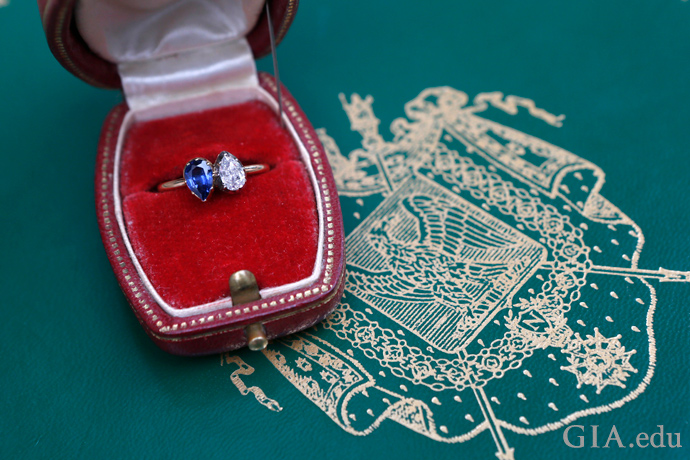
The Empress Josephine toi et moi (“you and me”) engagement ring features a 1 carat (ct) pear shaped sapphire and diamond mounted in 18K gold. Photo: PATRICK KOVARIK. Courtesy: AFP/Getty Images
Colorful gemstone engagement rings are decorating the fingers of royals and other style makers, reviving a not-so-new trend for adding pops of color – and personality – to traditional colorless diamond engagement rings.
Some stylistas are achieving the color-me look with pink, yellow or blue diamonds, while others turn to the world of colored gemstones to find their splash of color.
More than 200 years ago, in 1796, Napoleon Bonaparte gave his future empress, Joséphine, a sapphire and diamond toi et moi (“you and me”) ring for their engagement.
Today, Kate Middleton, the Duchess of Cambridge, wears what is probably the most famous colored gemstone engagement ring. A beautiful creation that once belonged to Princess Diana, it boasts a 12 ct sapphire encircled by diamonds.
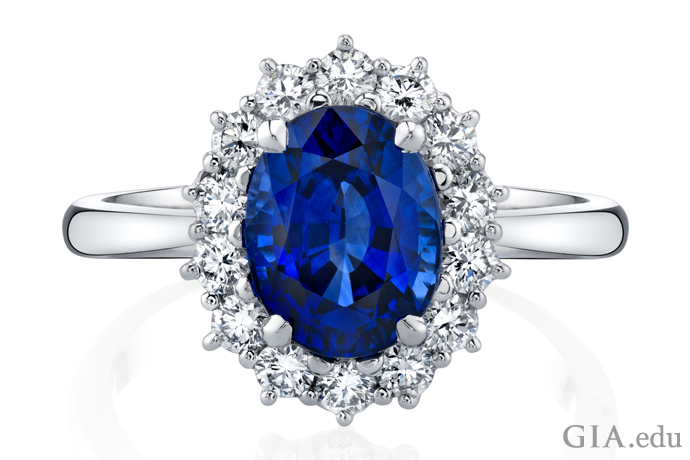
If you like Kate Middleton’s engagement ring, then you’re sure to love this beauty. A 2.73 ct oval sapphire glows the brighter for being accented by 0.56 carats of diamonds. Courtesy: Omi Privé
Kate’s recently engaged cousin by marriage, Princess Eugenie, daughter of Prince Andrew and Sarah Ferguson, opted for a slightly orangy pink padparadscha sapphire, surrounded by round brilliant cut diamonds. The style somewhat resembles the engagement ring her mother (the Duchess of York) received – a ruby with a halo of diamonds.
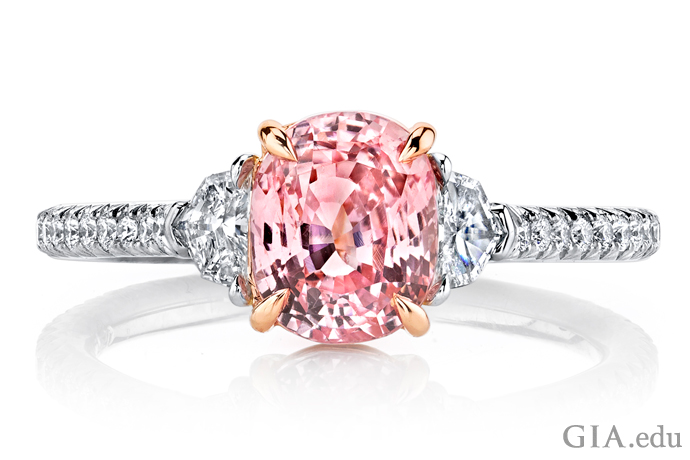
Like Princess Eugenie’s engagement ring, this 2.02 ct padparadscha sapphire and diamond ring is both beautiful and unusual. Courtesy: Omi Privé
In the celebrity world, actress Jenny McCarthy wears a 10 ct yellow sapphire engagement ring framed by diamonds. Ashlee Simpson’s vintage-style ring features a marquise diamond surrounded by calibré cut rubies. Elizabeth Hurley sports a 9 ct blue sapphire framed by two trilliant cut diamonds in a classic design.
For these trendsetters – and many other brides – incorporating colored gemstones into an engagement ring offers myriad options to display their individual style and personality. It’s a look that’s both timeless and contemporary.
There’s a lot to love about colored gemstone engagement rings. First, there’s the obvious: color. Explore the world of colored gems and you’ll find a rainbow, from the deep reds of ruby and blues of sapphire, to the grassy greens of tsavorite garnet and kaleidoscopic colors of spinel. There’s a gem for every hue imaginable.
Second, with colored gemstones you can add more depth of meaning to the engagement ring. For example, you could include your birthstone and your partner’s birthstone, alone or with diamonds. Colored gemstones also come with historic symbolism, and you could pick one that inspires you. Take sapphire – it has traditionally been associated with sincerity, truth and faithfulness.
You can also use colored gemstones to send secret messages. The Victorians turned this into an art form with acrostic jewelry – using the first letter of each gemstone to spell a word. For example, a diamond, emerald, amethyst and ruby set together would spell the word “dear.” Acrostic jewelry can also be designed to spell birthdays, private messages or a secret shared between you and your beloved.
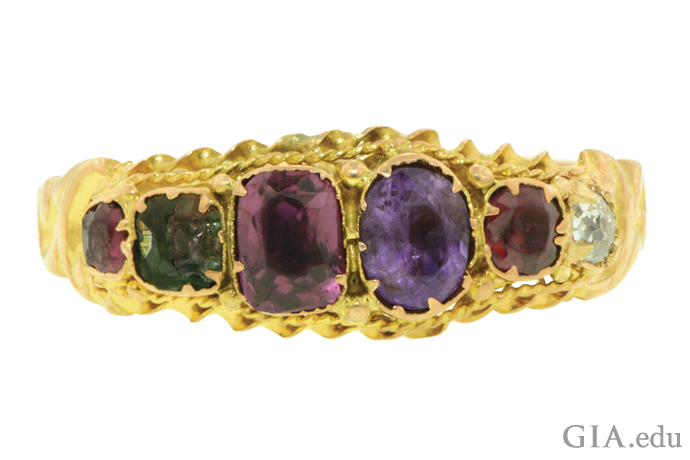
This acrostic ring was made in England during the Victorian era (1837–1901). The gems spell “regard” from left to right: ruby, emerald, garnet, amethyst, ruby and diamond. Courtesy: Doyle & Doyle
Finally, there’s affordability. Colored gemstones are a great way to add size to an engagement ring. This is especially true if you look beyond rubies and sapphires toward gems that are less well known but equally as beautiful – and usually significantly less expensive. Examples include the pink beryl morganite, the many colors of spinel and tourmaline, or intense green, red or orange garnets.
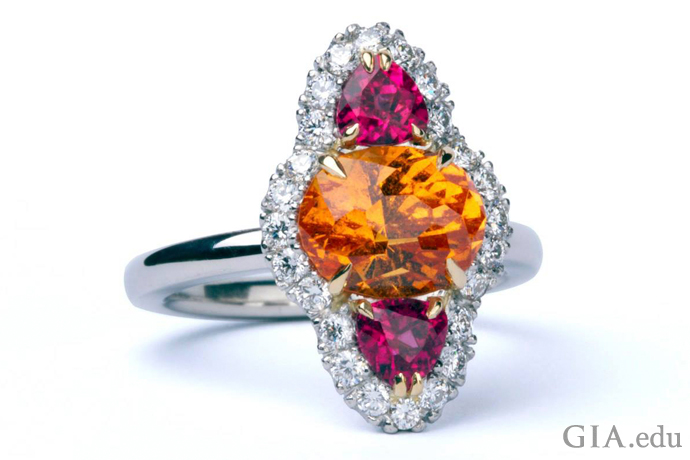
If your bride-to-be’s favorite colors are orange and pink, this ring featuring a spessartine garnet center stone cut by John Dyer, pink tourmaline side stones and diamond melee is sure to please. Courtesy: John Dyer & Co.

The color of morganite can be very similar to that of a pink diamond, but this 7.07 ct morganite is a striking – and more affordable – option. Courtesy: 1stdibs.com
Morganite engagement rings are recent favorites with brides-to-be – and for good reason. Pink has traditionally been the color of romance, and morganite ranges from pastel pink to purplish, yellowish or orangy pink. Similar hues are seen in pink diamonds, but you can have a large, attractive morganite for a small fraction of their cost.
Blue zircon, with its high dispersion, is often mistaken for blue diamonds. Yet while the cost of even a 1 ct blue diamond would be prohibitive for most buyers, a 3 or 4 ct blue zircon engagement ring is obtainable for far less than an average month’s salary.
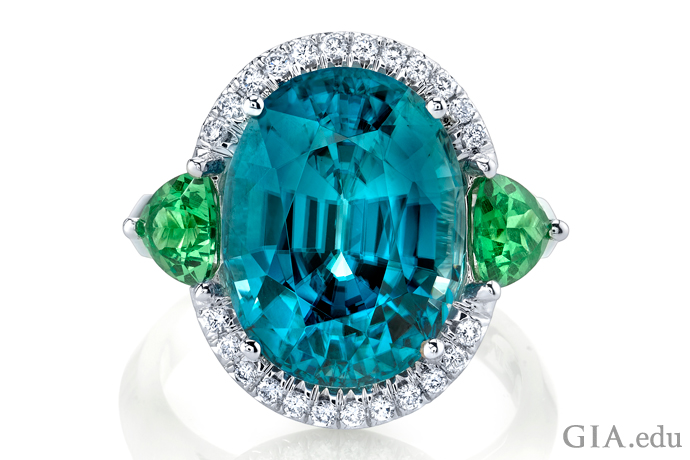
Find beauty in blue with this 6.74 ct cushion cut zircon ring accented with trilliant cut tsavorite garnet side stones and round brilliant cut diamonds set in 18K white gold. Courtesy: Omi Privé
Spinel and tourmaline are two other gems that offer a wide range of color options and great value. They occur in colors that are very similar to those of fine ruby or sapphire, but a top-quality 5 ct red tourmaline (rubellite) could be purchased for less than a third of the cost of a comparable 2 ct ruby – delivering more bling for your buck.
One of the most exciting, if less well known, colored gemstones seen in engagement rings is the green garnet known as tsavorite. More durable and often brighter than emerald, whose color it mimics, a fine tsavorite garnet is usually less expensive than its counterpart.

An alternative and more durable option than emerald, this 2.86 ct tsavorite ring with diamond accents stands out from the crowd. Photo: Emily Lane/GIA. Courtesy: Sara and Bret Keller
With so many different colored gemstones available, your challenge will be finding one that sets your heart aflame – and making sure the gem is tough enough for daily wear.
Durability is a major consideration when searching for an engagement ring gemstone. The gem you choose must withstand the bumps and bangs of daily wear, plus the effects of heat, light, household chemicals and low or high humidity. Different gemstones have different properties and, as a result, different tolerances to these stressors.
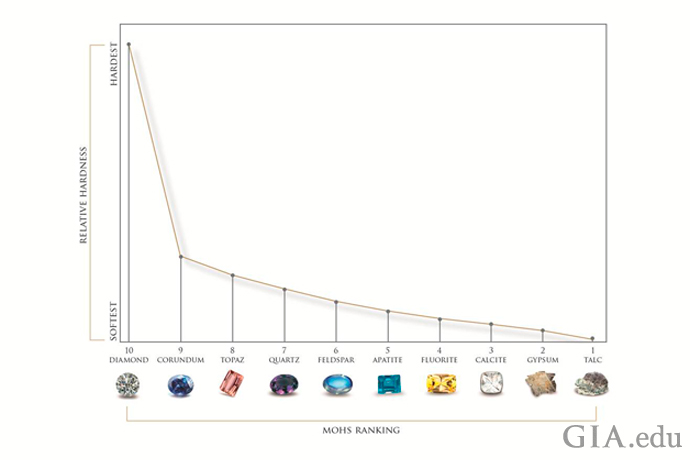
Introduced in the early 19th century, the Mohs scale ranks gem and mineral hardness in a range from 1 (least hard – talc) to 10 (hardest of all – diamond). Illustration: GIA
One aspect of gemstone durability is hardness. The Mohs scale ranks gem and mineral hardness on a scale of 1 (least hard – talc) to 10 (hardest of all – diamond). Ruby and sapphire rank 9, meaning they are able to resist scratching and abrasions. This makes them great choices for engagement rings that will see a lifetime of active wear. Although less hard, spinel (8), morganite (7.5–8), zircon (7.5), and tsavorite garnet and tourmaline (both 7–7.5) are considered durable enough for everyday wear provided care is exercised (no rock climbing!).
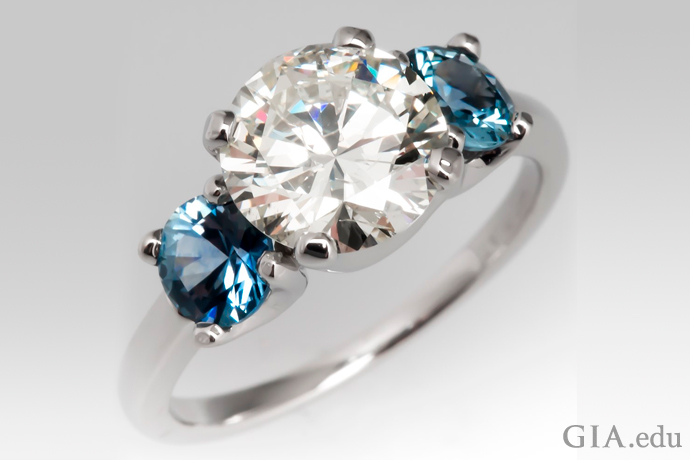
Two Montana sapphires weighing a total of 1.19 carats bookend a 2.05 ct round brilliant diamond. Courtesy: EraGem.com
Toughness and stability are two additional factors that determine a gemstone’s durability.
Toughness indicates how well a gemstone resists breaking, chipping or cracking. The way the atoms of a gem bond together and the strength of these bonds determine gemstone toughness. Examples of not-so-tough gems are opal and tanzanite which, if set in rings, are best reserved for special occasions – not everyday wear.
Stability refers to how well a gemstone can withstand exposure to chemicals, light and changes in temperature or humidity. Extreme temperature changes can damage some gems like opal and tanzanite. Opals can crack or craze in low humidity or with exposure to heat. Citrine, amethyst and topaz may fade or change color from prolonged exposure to sunlight. Light and/or heat can also negatively affect most organic gems – such as pearls, coral and amber – as will exposure to household chemicals.

Tanzanite is a beautiful gem that calls for special occasions. At 6 to 7 on the Mohs scale with fair-to-poor toughness, it’s not ideal for an engagement ring that will see a lifetime of daily wear. Courtesy: Omi Privé
It’s important to note that many colored gemstones are routinely treated to improve their color and/or clarity. Designed to bring out the inherent beauty of a gem, many of these treatments are widely accepted in the gem trade. However, you should be aware that some treatments can also affect stability. As a result, your gem may require special care.
For example, treatments such as coating and fracture filling can be removed by heat and strong chemicals. Although emerald ranks 7.5–8 on the Mohs scale, it is not a tough gem and is often treated with oil and/or resin to improve clarity. This treatment also disguises fractures in the stone that can cause it to break if banged against a hard surface. If you have your heart set on a green gemstone engagement ring you plan to wear every day, you might want to consider a more durable tsavorite garnet instead, reserving emeralds for earrings or pendants. Garnets are rarely treated and have good toughness.
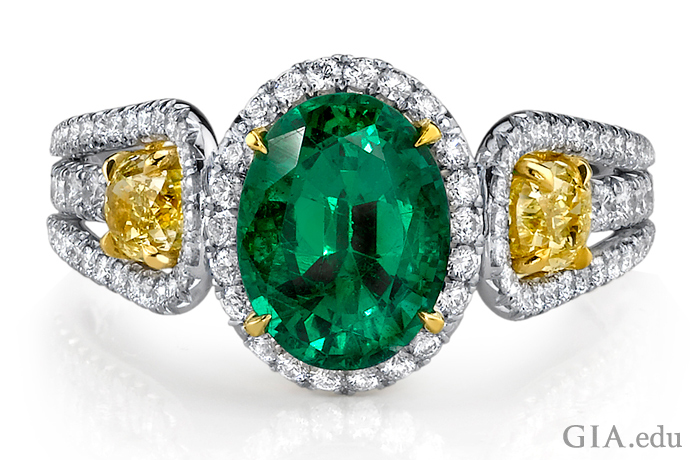
A halo of diamonds creates contrast with the emerald and helps protect this popular but fragile stone. Two yellow diamonds add more color and drama to the ring. Courtesy: Omi Privé.
Color is king
Like colorless diamonds, the quality of a colored gemstone is determined by a combination of the 4Cs: color, clarity, cut and carat weight. For colored gems, however, color is by far the most important factor. In some cases, such as whether a gem is called pink sapphire or ruby, or green beryl or emerald, the distinction may be made based on color alone. Clarity is important, but for most colored gems there is no universal grading system or set of standards to evaluate clarity. And cut may vary greatly from stone to stone. The goal is typically to maximize size and color – or, as in the case of fantasy cuts, to create a work of art.
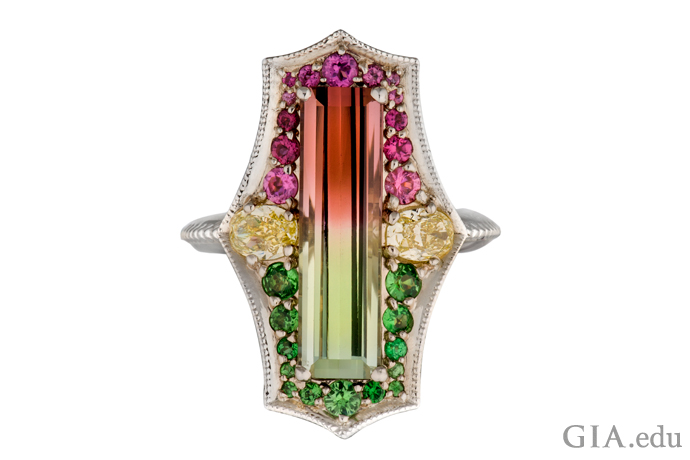
A piece of art to stand the test of time, this 9.05 ct bi-colored tourmaline ring set in 14K white gold features yellow diamonds, tsavorites and rubellites. Photo: Orasa Weldon/GIA. Gift of Derek Katzenbach. In Memory of Nicholas Scott Golden, University of Maine geology student.
There are, however, some important considerations to look for when assessing the quality of a colored gemstone in addition to the durability factors discussed above. Many gems show more than one color. This can be an asset in a bi-colored tourmaline – for the bride-to-be who wants a truly unique colored stone engagement ring.
In other gems, such as blue sapphire, colorless zones seen on close inspection may detract from the overall appearance of the gem. And while high clarity is desirable in most colored gems, as it is in diamonds, a few identifying inclusions in an inconspicuous area (such as the culet) may ensure that the colored gem is natural (not synthetic) and untreated.
Optical phenomena
Colored gemstones also offer the possibility of certain phenomena, such as chatoyancy (the cat’s-eye effect) and asterism (a star), that are not seen in diamonds. These phenomena are caused by the reflection of light off dense inclusions of minerals in gems cut as cabochons. Such phenomenal stones provide exciting design options for a colored gemstone engagement ring.

This 7.57 ct cat’s-eye chrysoberyl seems to symbolize two lives united as one. Add a sparkling halo of round brilliant cut diamonds for strength and you have the perfect sentiment for an engagement ring. Photo: Robert Weldon/GIA. Courtesy: Richard Krementz Gemstones
Where the gem comes from
For some gems, such as ruby and sapphire, country of origin may also play a significant role in determining value. For example, a ruby from Myanmar (“Burmese” ruby) can cost significantly more than a comparable ruby from another locality, such as Mozambique. Similarly, there is a premium for sapphires from Kashmir, due to both their distinctive “cornflower blue” color and their rarity: There has not been major production from this region for more than a century.
Who owned it before
Another important factor in determining price is historical provenance. An antique or vintage colored gemstone engagement ring may come with its own story, and that story may have value. In one of the most striking examples, when the Empress Josephine sapphire and diamond engagement ring mentioned above was offered at auction in 2013, the auction house estimated its value at $20,000 based largely on the gems alone. Ultimately, the winning bidder paid more than $1 million – a huge premium for the ring’s storied association with Napoleon Bonaparte and his first bride.
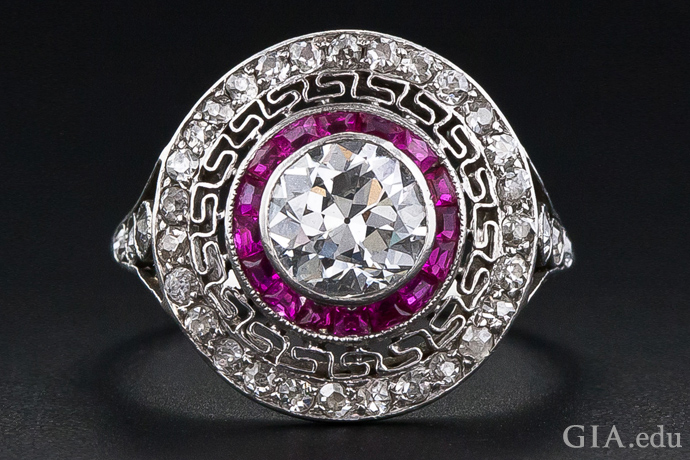
A ring of Burmese rubies encircles an Old European cut diamond in this Art Deco–era ring. A Greek key motif made of platinum circles the rubies, while another ring of diamonds completes the design. Courtesy: LangAntiques.com
Quality and rarity drive value
Like diamonds, colored gems of high quality are rare, so buyers typically pay a premium for top-quality colored stones. Once you’ve decided on a gemstone for your engagement ring, it pays to comparison shop to understand its quality factors and how they affect value. You should also learn as much as you can about your gemstone of choice. GIA’s Gem Encyclopedia is a good place to start. It provides in-depth information for 29 of the most popular gems on the market. You’ll also find detailed buying guides for each gem describing the specific qualities to look for, the gem’s durability, common treatments and more.
After you’ve purchased your colored gemstone engagement ring, you’ll want to keep it like new. The right way to clean it will vary depending on the gem material you’ve chosen and whether or not it’s been treated. Usually, gentle cleaning solutions specially formulated for delicate gems – or just warm, soapy water and a soft cloth – are all you need. If you’re uncertain about the durability of your gem, avoid using ultrasonic cleaners and off-the-shelf cleaning solutions.
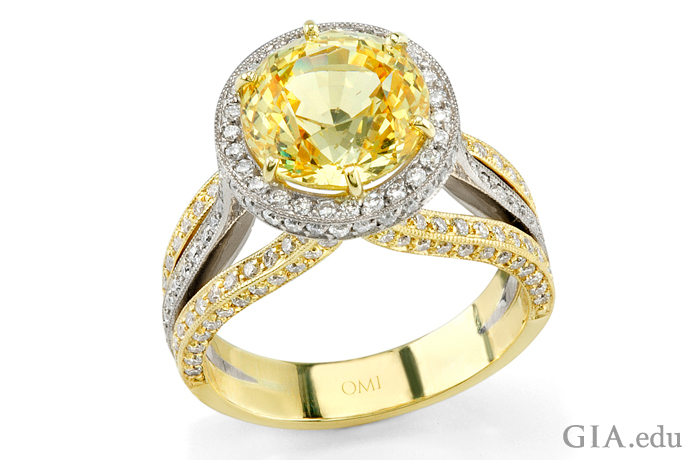
Washing with warm, soapy water is the safest way to clean this 5.11 ct yellow sapphire engagement ring, which is surrounded by 128 round diamonds weighing 0.75 carats. Courtesy: Omi Privé
Engagement ring settings must secure the gems they hold as well as show them to their best advantage. Bezels, halos and other protective settings can play an important role in preventing the chipping or cracking of colored gemstones. But who said practical can’t also be beautiful? Settings serve as an essential design element, defining an engagement ring’s style and overall look. Settings let you introduce contrasts in color or harmonize them to get just the right amount of color pop in your ring. Consider these examples:
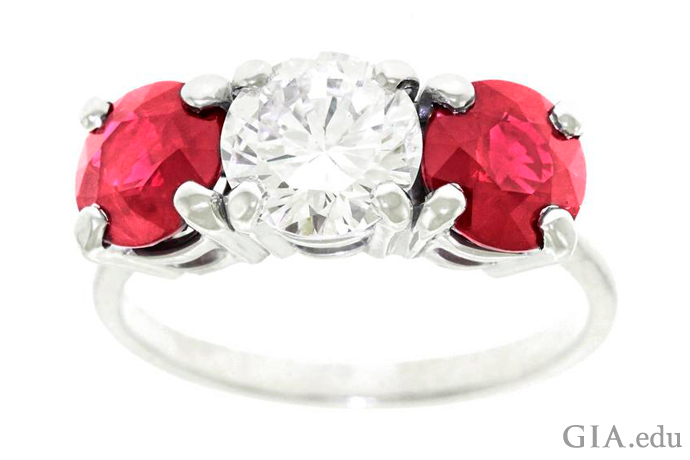
Create a fiery look in an engagement ring by using this three-stone ring for inspiration. The two rubies (1.41 ct and 1.37 ct) bracketing the 1.39 ct round brilliant diamond are sure to catch the eye. Courtesy: 1stdibs.com

Need more proof that colored gemstones can bring excitement to an engagement ring? This stunning creation features a 2.57 ct spinel encircled by 0.20 carats of round diamonds. Courtesy: Omi Privé

The diamond and sapphire in this Victorian-era bypass ring make for a delicate pairing. Courtesy: Treasurly by Dima
Jewelry designers are putting a contemporary stamp on three-stone, halo and bypass rings with colored gemstones. Their modern updates are a beautiful melding of past and present – pieces that pop with color and life. Look around and you’ll find a number of creative interpretations.
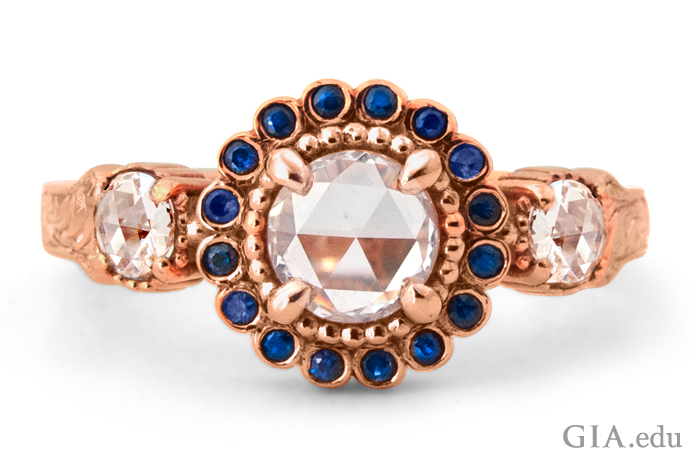
Something old. Something new. Something borrowed. Something blue. Blue sapphires surround a rose cut diamond in this modern ring with a design borrowed from the Victorian era. Courtesy: Shelly Purdy Studio

A pear shaped sapphire is surrounded by colorless diamonds and a second halo of sapphires. Diamonds and sapphires spill down the shank of the ring. The bold contrasting colors create a visual richness sure to please. Courtesy: Omi Privé
Now that you know about colored gemstone engagement rings, you’re ready to start shopping. But where? The GIA Retailer Look Up lets you easily find local retailers who have GIA-trained staff to help you through your gemstone selection process.
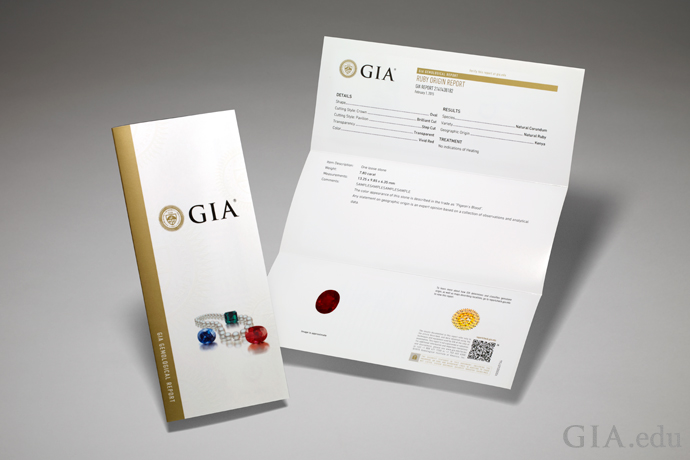
Before you decide on a colored gemstone engagement ring, ask for a GIA Colored Stone Identification Report.
To make sure you get the best value, ask for an unbiased GIA Colored Stone Identification Report. The report will validate the gem’s identity and include detailed descriptions of its size, color and measurements, along with a color photograph. The report will also indicate whether the gem has been treated and, if it has, identify the type of treatment – important to knowing how to care for your gem. Depending on the gemstone, you may also be able to get information on its geographic origin.
Need more inspiration for colorful engagement rings? Read our article on how to buy antique and vintage engagement rings for some exciting examples.
A GIA diamond cut grade is key to knowing how well your round brilliant diamond will sparkle. Cut is the most complex of a diamond’s 4Cs. Let’s cover some essentials so you can pick the perfect round brilliant diamond engagement ring.
In this blog, we cover:
The most popular diamond in the marketplace is the round brilliant. Experts estimate that this cut alone accounts for more than 70% of all diamonds sold today. The quality of a round brilliant diamond’s cut determines how much the diamond sparkles. To pick a diamond whose flashes of light enchant the eye, you need to know the 4Cs of diamond quality, the universal standard for judging diamonds: color, cut, clarity and carat weight. All else being equal, the better the cut grade, the more valuable the diamond.
Some professionals consider cut the most important C of diamond quality. A well-cut round brilliant delivers that unmistakable, stop-in-your-tracks light show that telegraphs “diamond” across a crowded room. If the diamond is well cut, most compromises in clarity, color and even carat weight can be forgiven. A diamond’s cut grade is also an indication of how well it was designed and crafted. So, understanding the diamond cut grade is key to picking a round brilliant that’s not only beautiful, but also the best value.
In arriving at its cut grading system, GIA spent 15 years studying how light behaves within a round brilliant cut diamond. GIA’s aim was to understand the factors that contribute to a round brilliant’s appearance and to determine which of those factors – or combination of factors – produce diamonds that people consider attractive.
GIA’s research included the use of advanced computer modeling to analyze tens of thousands of possible proportion combinations. GIA then validated its research with human subjects, conducting more than 70,000 observations on actual diamonds, to determine which diamonds people found appealing and why.
The result was the GIA Cut Grading System, which evaluates the cut quality of a round brilliant diamond along a five-point scale ranging from Excellent to Poor.
A GIA cut grade evaluates:
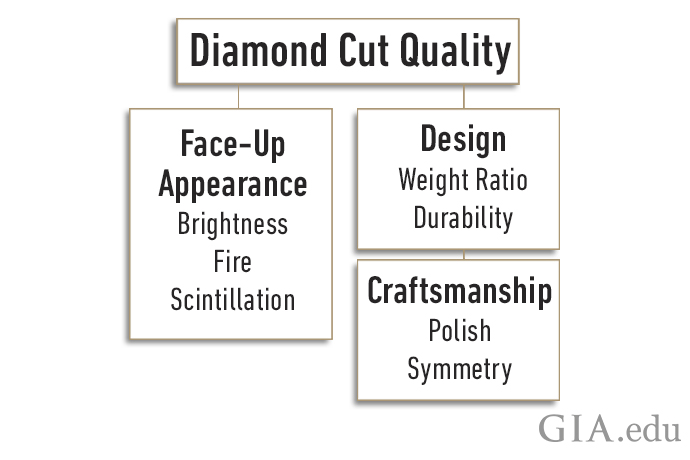
The GIA diamond cut grade is based on seven factors: brightness, fire, scintillation, weight ratio, durability, polish and symmetry.
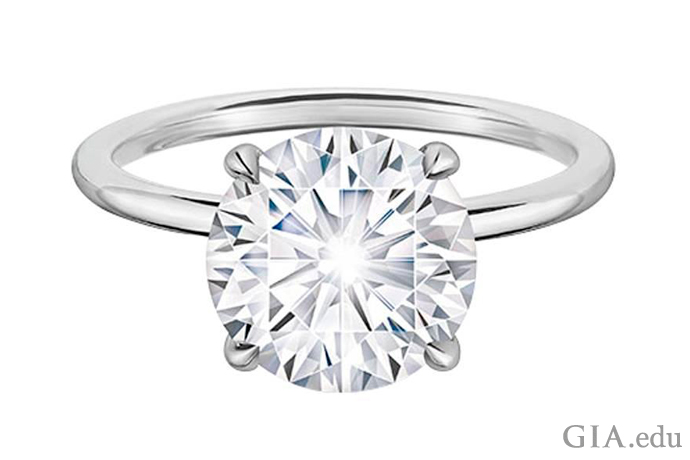
This 2.02 carat (ct) round brilliant has excellent cut, polish and symmetry. Courtesy: 1stdibs.com
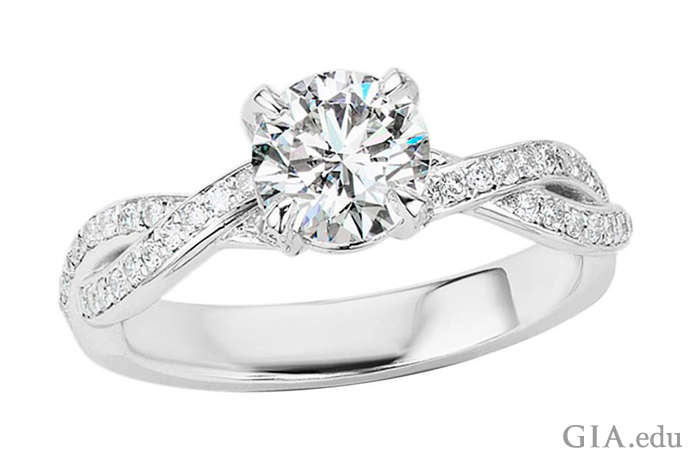
The reason behind the sparkle of this 1.01 ct round brilliant cut diamond engagement ring is the quality of the diamond’s cut. The diamond received an Excellent cut grade from GIA. Courtesy: 1stdibs.com
A key component of a GIA diamond cut grade is the diamond’s face-up appearance – or how the diamond looks when viewed from above, as if it was set in an engagement ring. People love diamonds for their dazzling interplay with light – which the layperson often translates as “sparkle.” But there’s a lot more going on here.
When you see internal and external white light reflected from a diamond, you’re noticing “brightness.” If you see the scattering of light into all the colors of the rainbow, you’re being treated to “fire.” Sparkle is actually “scintillation,” the pattern of bright and dark areas caused by reflections within the diamond as it or the light source moves. What you might consider “sparkle” is really the overall visual effect of these three factors. A GIA cut grade includes an assessment of how well a diamond delivers on each of these attributes.
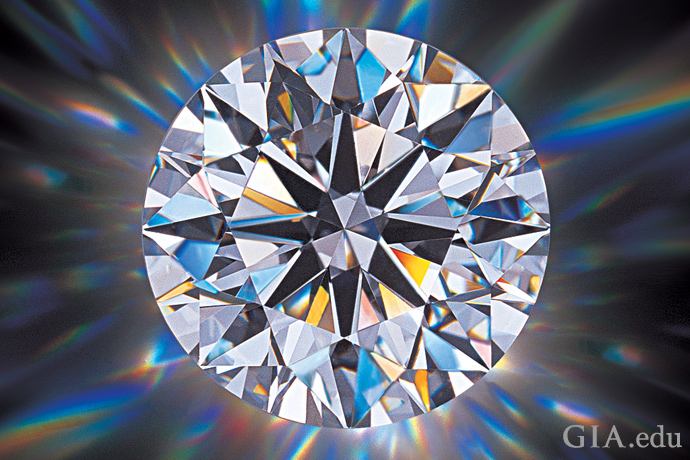
This round brilliant cut diamond shows good brightness and fire. Scintillation, the pattern of light and dark areas and the flashes of light, or sparkle, can only be seen when a diamond is moved. Copyright: GIA & Harold and Erica Van Pelt
A diamond’s proportions – its crown and pavilion angles and the relative measurements of its facets – are key contributors to a diamond’s overall face-up appearance. Remember that facets are tiny mirrors. Their size and placement will influence how light behaves as it passes through the diamond and back to your eye.
A diamond’s proportions can help predict how well a diamond will deliver brightness, fire and scintillation. However, an important outcome of GIA’s cut research was the finding that there is no single set of proportions that defines a well-cut round brilliant diamond. In fact, diamonds with different proportions can receive the same cut grade. The diamonds may look and perform differently but they will still have a similar impact on the observer. So, as a diamond shopper, you need to look beyond the measurements on a grading report. Be sure to view a diamond in person to see if it’s the right choice for you.
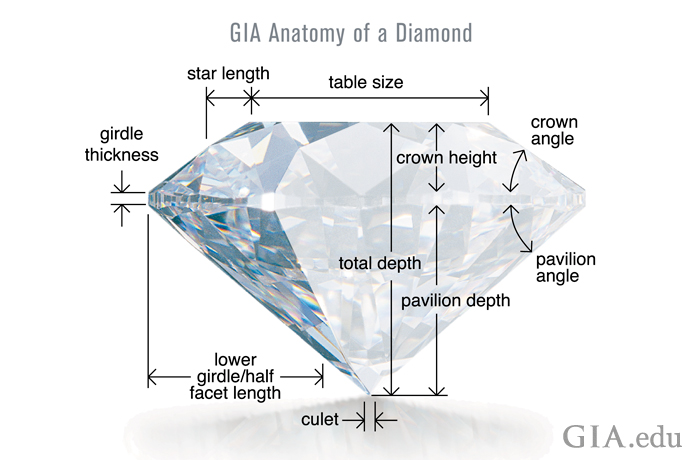
This graphic illustrates the proportions that affect a diamond’s cut grade. The crown and pavilion angles and the relative measurements of its facets contribute to a diamond’s brightness, fire and scintillation.
While face-up appearance is all about how a diamond looks, design and craftsmanship evaluate the quality of the diamond’s manufacture. Poor design could add unnecessary weight to a diamond or cause durability issues that would prevent you from enjoying it for a lifetime. A diamond with poor craftsmanship won’t deliver much in the way of brightness, fire and scintillation. In evaluating these two components, the GIA Cut Grading System takes into account the diamond’s physical shape, its proportions, its weight ratio, and the care that went into fashioning and polishing its facets.
Design
Design refers to decisions made during the fashioning process that determine the diamond’s physical shape, as seen in its proportions, weight ratio and durability. Weight ratio is the diamond’s weight in relation to its average girdle diameter (a fairly complex mathematical equation). A diamond with a smaller girdle diameter relative to its weight might appear smaller face-up than its well-designed counterpart, because much of the weight would be “hidden” in the overall depth of the diamond. For example, while a diamond with a thicker girdle could look great, the girdle is hiding unnecessary weight. As a result, you might end up paying more for a heavier diamond with no greater visual impact for the added cost. The bottom line: A diamond should not weigh more than its face-up size would indicate.

These pictures show the importance of weight ratio. Both of these diamonds have the same average girdle diameters, so face-up they appear to be the same size. But the diamond on the right has a much thicker girdle, so it weighs more (0.71 ct vs. 0.61 ct). The thicker girdle has no visual benefit, but the added weight will make the diamond more expensive. Photos: Maha Tannous/GIA
Durability in the case of a round brilliant diamond refers to the risk of damage that might result from an extremely thin girdle. Such a girdle can make a diamond highly vulnerable to damage during the jewelry setting procedure or even normal wear. Considering how much a diamond costs and its emotional significance, you want to avoid one that is susceptible to damage. A GIA Diamond Grading Report can eliminate this concern.
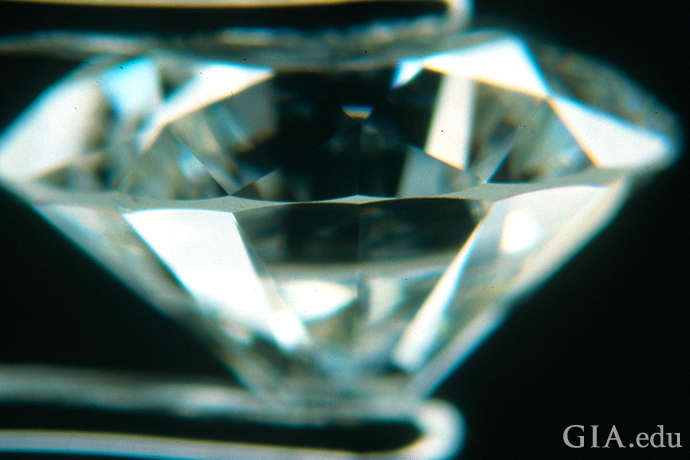
Here is an example of why durability is important. This 1.35 ct diamond has girdle areas that are very thin to extremely thin, making it more susceptible to damage during everyday wear. Courtesy: Gary Roskin, G.G., F.G.A.
Craftsmanship
Craftsmanship describes the care that went into fashioning the diamond, as seen in its polish and symmetry. Polish refers to the overall quality and condition of the facet surfaces. It includes evaluation of any blemishes created by the polishing process or during wear. Polish is critical to the mirror-like performance of a diamond’s facets.

The diamond on the left shows lines created during the polishing process. The diamond on the right has abraded facet junctions caused by wear. Polish lines and abraded facet junctions can also affect a diamond’s clarity grade. Photos: Mitchell Moore/GIA
Symmetry is the exactness of a finished diamond’s shape and the arrangement and placement of its facets. A symmetrical diamond has an even display of brightness, fire and scintillation. A diamond with poor symmetry will have poor light performance, meaning that it’s likely to look flat.

All eight sections of a round brilliant cut diamond should be identical. This symmetry will help produce even brightness, fire and scintillation. Illustration: GIA
GIA evaluates a round brilliant diamond’s cut based on seven components – brightness, fire, scintillation, weight ratio, durability, polish and symmetry – to arrive at a GIA diamond cut grade, which ranges from Excellent to Poor. The grade is set by the lowest assessment the diamond receives for five of the seven components. In other words, if a diamond receives a Poor grade for brightness, then the highest its overall cut grade can be is Poor. The exceptions are polish and symmetry, which are assessed using standard GIA grading methodology: A diamond with Very Good polish and/or symmetry, for example, may receive an Excellent cut grade.
A GIA Diamond Grading Report contains the diamond’s full cut assessment, in addition to a diagram showing the diamond’s proportions and relative measurements. Consider the report an invaluable tool in helping you pick a dazzling diamond.
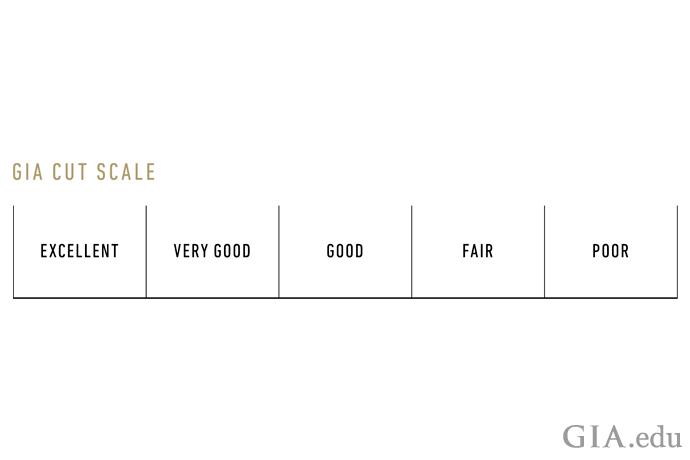
The official GIA Cut Scale for round brilliant cut diamonds. Illustration: GIA
While knowing a diamond’s cut grade is essential, it shouldn’t be a substitute for seeing a diamond in person. As mentioned above, a diamond cut grade represents a range. For example, two diamonds with an Excellent Cut Grade may look – and perform – very differently. In addition, a diamond will look different under various lighting conditions, so you should take it for a test drive, so to speak. Last, you need to fall in love with the diamond – and no report can substitute for what stirs your heart.

An Excellent cut grade makes this 2.03 ct round brilliant diamond mesmerizing. Courtesy: 1stdibs.com
Diamond cut is extremely important. So is diamond color. Learn about it, too, so you can pick a spellbinding diamond.
Diamond clarity is the relative absence of inclusions and blemishes. You should know about this 4Cs quality factor because it affects a diamond’s beauty and value. To understand what a diamond clarity is, use these tips to help you shop smartly:
Diamond clarity is one of the 4Cs (the others being color, cut and carat weight). It plays an important role in determining a diamond’s overall beauty and ultimately its value. Diamond clarity refers to inclusions in the diamond and blemishes on its surface.
Inclusions and blemishes can result from a diamond’s formation, its crystal structure, the cutting-polishing-setting processes, or general wear. Inclusions can be totally enclosed within the diamond or they can extend into the diamond from its surface. Blemishes are confined to the diamond’s surface. Gemologists use 10× magnification to determine a clarity grade.
You may hear some people describe inclusions and blemishes as “flaws.” But most gemologists think of them instead as powerful identification tools. Inclusions can help in the separation of some natural diamonds and synthetic diamonds. And because most diamonds have a unique combination of inclusions and blemishes, these clarity characteristics act like fingerprints, giving each diamond its own identity.
If you’re wondering whether your diamond’s laser inscription is considered a blemish or inclusion – the answer is neither. A laser inscription is not considered a clarity characteristic.
To help you understand what diamond clarity is, here are pictures and descriptions of 16 types of inclusions and 11 types of blemishes commonly seen in diamonds.
When it comes to diamond clarity and value – like diamond color and value – less is always more. Diamonds with few or no clarity characteristics are rare and because rarity drives price, they will cost more. In fact, diamonds without any visible clarity characteristics under a 10× jeweler’s loupe are called “flawless.” These diamonds are so rare that many jewelers may never see one in their career.
Less expensive diamonds often have inclusions that can be seen with the unaided eye. Most faceted diamonds fall between the two extremes – they have inclusions visible only with magnification.

Diamond clarity affects a diamond’s appearance. A diamond with many inclusions and blemishes can look off-color, pitted and scratched. This diamond has a clarity grade of I3. Photo: GIA
Clarity characteristics may be more visible in certain diamond cuts than others. For example, they will typically be easier to see in an emerald cut diamond compared to a round brilliant cut diamond. The long, rectangular facets that are characteristic of emerald cut diamonds make inclusions more readily visible than among the many smaller facets of a brilliant cut. However, if a diamond has many large clarity features, or if they are mirrored by the diamond’s many facets, they will be easy to see – no matter the shape or cutting style.
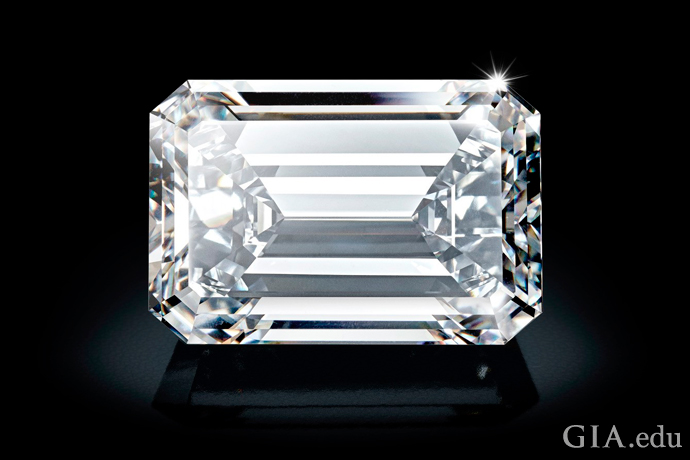
This 163.41 carat (ct) D-Flawless emerald cut diamond is a thing of uncommon beauty. Inclusions or blemishes visible with the unaided eye would mar its appearance. Courtesy: Christie’s
It’s worth noting that inclusions normally have more impact on a stone’s beauty and value than blemishes. This is because many blemishes are easy to remove. A fashioned diamond can sometimes be recut or repolished to eliminate blemishes and possibly improve its clarity grade.

If all other factors are equal, as clarity increases so does diamond price per carat. Illustration: Peter Johnston/GIA
Diamond clarity is described using standard terminology developed by GIA in the 1950s. The grades are based, in part, on the visibility of inclusions and blemishes with 10× magnification by a trained grader. The GIA Diamond Clarity Scale is used to decide what diamond clarity is. It has six categories, some of which are subdivided, for a total of 11 specific grades for natural diamonds.
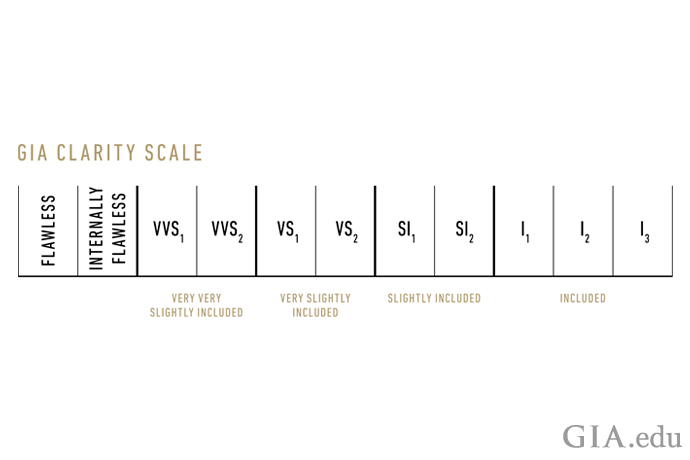
The GIA Diamond Clarity Scale has 11 grades, which range from Flawless to I3.

This 2.78 ct D-color round brilliant cut diamond is Internally Flawless. Photo: Robert Weldon/GIA. Courtesy: Rogel & Co. Inc.
Here are two other terms you might come across.
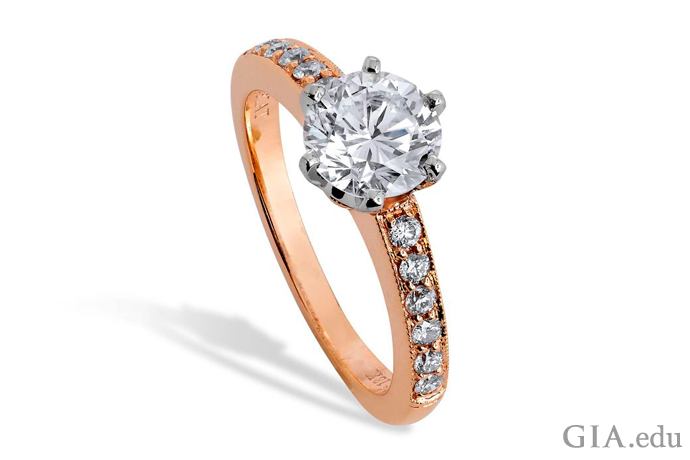
The beauty of this 1.40 ct F color, SI1 clarity round brilliant cut diamond is undeniable. The six-prong platinum basket and 0.20 carats of diamond melee in an 18K rose gold shank add extra charm. Courtesy: 1stdibs.com
Just as GIA developed the globally recognized terms for grading diamond clarity, it also developed the processes for objective and unbiased diamond clarity grading . GIA procedures include viewing a diamond under controlled lighting conditions, using specific viewing angles and distances, and following precise steps that ensure every part of the diamond is examined to locate all the inclusions and blemishes that might affect its clarity.
A GIA diamond grader examines the diamond using her trained eye, a 10× jeweler’s loupe and sometimes a microscope at increased magnification. However, the final clarity grade is always determined by the diamond’s appearance under a 10× jeweler’s loupe.
In arriving at a clarity grade, the grader takes into account five factors:
A diamond may have many tiny inclusions and still be high on the clarity scale. Ultimately, it’s the combination of these five factors that affects the overall clarity appearance. Blemishes, in contrast, can often be removed when a diamond is polished or repolished, so they rarely have an effect on grades lower than IF.

The 10.21 ct emerald cut diamond featured in this engagement ring received a diamond clarity grade of VS2. Courtesy: TrueFacet.com
Manufacturers sometimes try to improve diamond clarity to make stones more attractive and more valuable. Here are two common methods used to accomplish this.
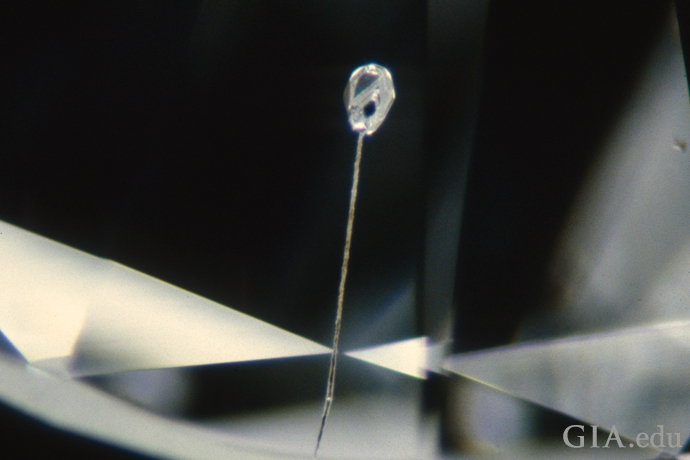
As seen here with 30× magnification, a thin channel has been laser drilled from the surface of the diamond to a large inclusion that was then vaporized or dissolved. Photo: Vincent Cracco/GIA
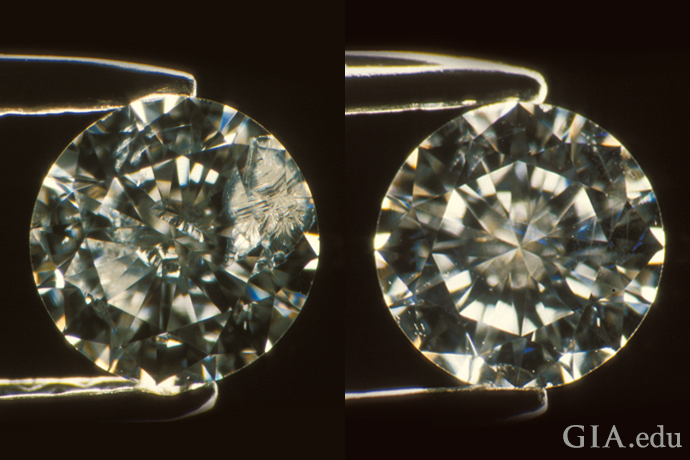
A 0.20 ct diamond with large, highly visible reflective fractures is shown here before (left) and after (right) filling with a glass-like substance. Photos: Shane F. McClure/GIA
Generally, if a diamond has significant durability problems, it doesn’t survive the friction and pressure of the cutting process. However, certain types of inclusions, especially if they’re near the girdle – the narrow section that separates the diamond’s upper (crown) and lower (pavilion) parts and functions as its setting edge – can make a cut diamond more vulnerable to damage. For example, if the stone is hit precisely on a feather or other surface-reaching inclusion, it might chip. Likewise, very deep feathers that extend from the crown to the pavilion, or that penetrate about one-third of the way or more into the diamond, could pose durability concerns.

The GIA Diamond Grading Report for diamonds on the D-to-Z color scale features a plotting diagram (bottom center panel), which maps a diamond’s inclusions and blemishes as viewed from the crown (left) and pavilion (right).
The GIA Diamond Grading Report, the GIA Diamond Origin Report and the GIA Diamond Dossier provide an objective, unbiased assessment of diamond clarity along with the other “Cs” of diamond quality.
A GIA Diamond Grading Report and GIA Diamond Origin Report contain a plotting diagram that maps the diamond’s inclusions and blemishes. The diagram shows the diamond’s shape and facet arrangements as seen from two views: the crown and pavilion. Symbols are used to represent the type, location, relative size and sometimes the shape of the clarity characteristics being plotted. In addition to providing details about a diamond’s clarity features and describing the diamond’s clarity, the diagram can also assist in diamond identification. No two diamonds below Flawless and Internally Flawless have exactly the same combination or placement of clarity characteristics.
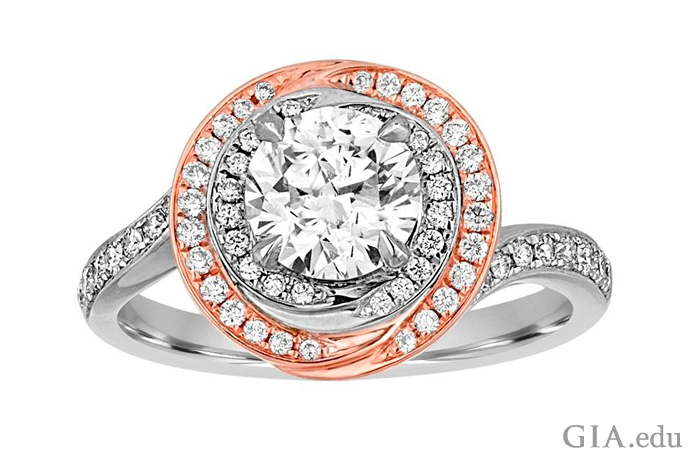
In this engagement ring, a 1.05 ct round brilliant cut diamond is surrounded by a double halo of diamond melee in an 18K white and rose gold setting. The many facets of a brilliant cut diamond make inclusions less visible than they would be in some other cuts, such as the emerald cut. Courtesy: 1stdibs.com
Now that you’ve brushed up on some diamond clarity essentials and know what color and clarity grades are good for your diamond, you just might be wondering: What’s the most important C of diamond quality?
A yellow diamond engagement ring is a stunning choice to celebrate your love. But picking the perfect engagement ring requires knowing about yellow diamonds, mountings, the effect of metals on appearance, treatments and more. We offer help.
Here are a few things you’ll need to know:
A fancy-color yellow diamond falls outside the GIA D-to-Z color range
GIA assigns one of six “fancy” color grades to your yellow diamond engagement ring
Don’t expect a round diamond for your yellow diamond engagement ring
Mountings can make a yellow diamond look darker
The metal used affects the appearance of a yellow diamond engagement ring
Some yellow diamonds might be treated, lab grown or both
Make sure GIA grades the diamond in your yellow diamond engagement ring
A yellow diamond engagement ring is rare because yellow diamonds are rare
Understanding diamond color is essential before you go shopping for a yellow diamond engagement ring. Most colorless or near-colorless gem-quality diamonds are graded based on the absence of color, using GIA’s D-to-Z diamond color-grading system. Yellow diamonds are considered to be colored diamonds and are graded as “fancy” when they have more color than the Z masterstone.
Here is another important difference between yellow diamonds and colorless diamonds. Diamonds in the D-to-Z range usually decrease in value as the color becomes more obvious. The opposite happens with fancy-color diamonds. Their value generally increases with the strength and purity of the color.
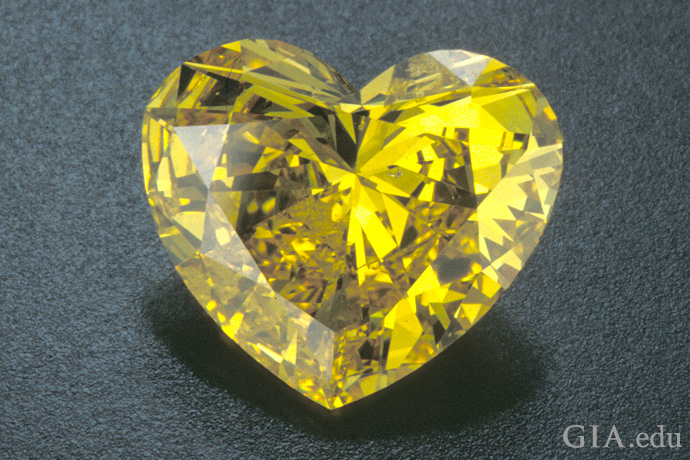
Colored diamonds graded Fancy Intense are often prized over those with other fancy grades. This yellow heart shaped diamond speaks of the first blush of love. Photo: Robert Weldon/GIA

Fancy-color diamonds are often cut into fancy shapes, like a pear shape, to bring out the color. Sunny days lie ahead for the bride wearing this 5.33 carat (ct) Fancy Yellow pear shaped diamond. Courtesy: 1stdibs.com
The names used to describe colors are often quite subjective. Consider that the color yellow includes variations like butter, lemon, golden and more. To bring objectivity and standardization to the grading of the rare beauties that are colored diamonds, GIA created the GIA Colored Diamond Color Grading System in the 1950s and refined it over the decades. This grading system not only defined the processes for determining a diamond’s color, but it also established the terms, or color grades, for describing it.
GIA’s grading system places most colored diamond in one of nine categories based on the diamond’s hue, tone and saturation: Faint, Very Light, Light, Fancy Light, Fancy, Fancy Intense, Fancy Dark, Fancy Deep and Fancy Vivid. The first three grades aren’t used for yellow diamonds, so the scale for yellow begins with Fancy Light. The majority of yellow diamonds in the jewelry industry are graded Fancy Light, Fancy, Fancy Intense and Fancy Vivid.
In general, the more color a colored diamond has, the better. Fancy Deep and Fancy Vivid diamonds, for example, have more color than Fancy Light diamonds—and are usually more valuable. However, tone (the degree of darkness or lightness of a color) is also important. For example, a diamond that is extremely dark (Fancy Dark) may be less desirable than a lighter stone graded Fancy Intense.
It is not unusual for a yellow diamond to have a hue modifier, such as orangy yellow or greenish yellow. A modifier does not indicate that the color is any less strong or pure.

This chart shows the subtle transitions in GIA’s color grading of yellow diamonds. Note, too, that the fancy grades represent a range of color sensations, not a “single” color sensation. Photo: Elizabeth Schrader and C. D. Mengason/GIA
Round diamonds cut in the brilliant faceting style are the most popular diamonds for engagement rings, but you may have a challenging time finding a round stone for your yellow diamond engagement ring. That’s because yellow diamonds typically display a more intense face-up color appearance when they’re cut in a shape other than round. These non-round shapes are called fancy shapes, which include oval, pear, marquise and heart, plus square or rectangular cuts like princess, radiant and emerald.

This 10.12 ct Fancy Vivid yellow pear shape is an example of a fancy-shape diamond. This shape was most likely selected to intensify the yellow color. Photo: Elizabeth Schrader/GIA. Courtesy: The Scarselli Family
If your heart is set on a yellow diamond engagement ring, you will probably look at a number of loose yellow diamonds. Be aware that the yellow diamond that has caught your eye may appear darker when set in a mounting.
Look at the photos below. The diamond on the left in the top image was graded Y–Z range, just on the light yellow/Fancy Light yellow boundary. It is shown next to a Fancy yellow reference diamond. In the bottom image, the larger diamond is mounted in a ring and placed next to the same reference diamond.
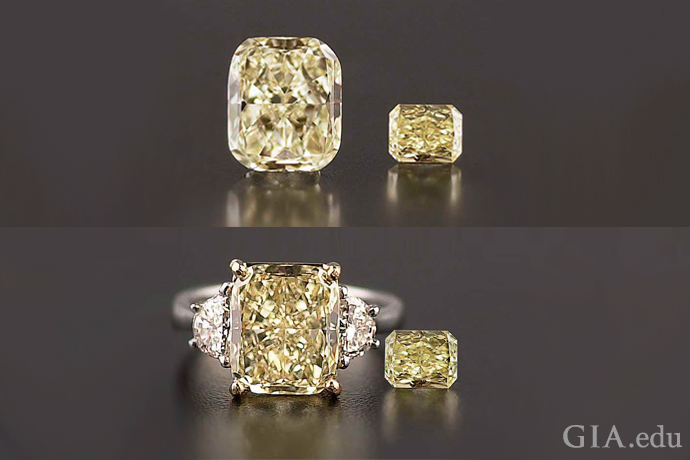
A yellow diamond is likely to look darker once it’s set in a mounting. Photos: Elizabeth Schrader/GIA. Courtesy: The Scarselli Family
This effect can actually work to your advantage, particularly if you’re deciding between a less expensive “light yellow” diamond at the very low end of the D-to-Z color scale and a more expensive Fancy yellow diamond.
Diamonds are highly reflective. Their facets are like tiny mirrors, reflecting their surroundings, which include the color of the ring and the prongs holding the gem. Because of this, the color of the metal will affect a diamond’s appearance.
You’ll typically have three choices when picking a metal for your yellow diamond engagement ring:
Do you want your engagement ring to highlight the color of the yellow diamond? White metals and rose gold will create contrast between the mounting and the stone. White gold makes for a streamlined, sophisticated look. A rose gold mounting will create a warmer contrast.
Do you want your ring to complement the color of the diamond? A yellow gold mounting will harmonize with a yellow diamond. Take a look at Art Deco style engagement rings, Retro style engagement rings and ring styles typical of the Victorian era, times when yellow gold was in fashion, to see if these are designs you’d like to recreate for your yellow diamond engagement ring.
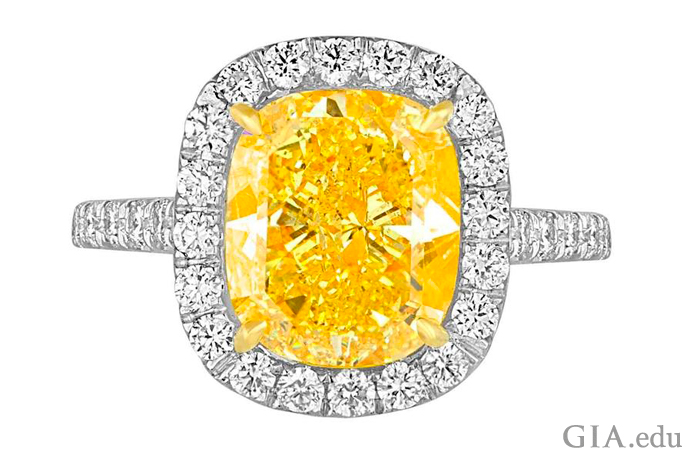
Want your yellow diamond to pop? Set it in a white metal ring. This 4.76 ct Fancy Vivid yellow diamond is so bright that it appears to have captured a ray of the sun. A halo of colorless diamonds surrounds it. Courtesy: 1stdibs.com

Rose gold is another way to create contrast with a yellow diamond. In this ring, it acts as a subtle counterpoint to the 3.46 ct yellow oval diamond. Courtesy: 1stdibs.com
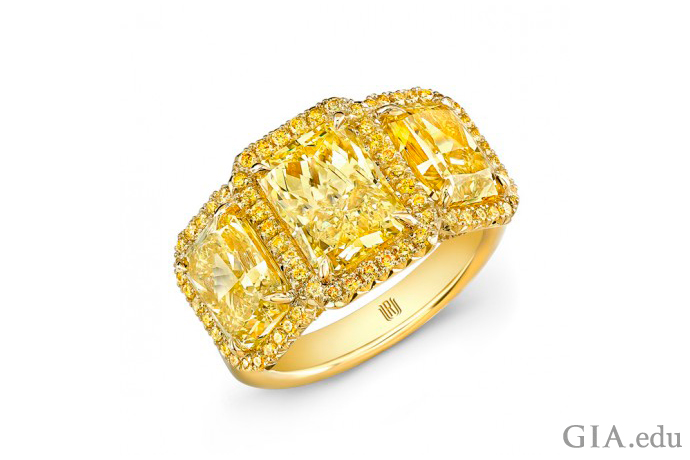
A yellow gold band paired with yellow diamonds creates a harmonious look. The three yellow diamonds set in 18K yellow gold are sure to soothe the eye as they captivate it. Courtesy: Rahaminov Diamonds
Off-color diamonds that are brownish or yellowish can be treated to modify their color. Manufacturers typically use one or both of two different processes:
In both cases, the treatment is considered permanent under normal conditions of wear and care. Non-permanent treatments, like coatings, are also possible. All else being equal, diamonds that have not been treated are more expensive than diamonds that have been treated. Legally, the seller must disclose any treatments. GIA can detect these treatments, and it identifies them in the GIA Colored Diamond Grading Report. It also laser inscribes “HPHT PROCESSED” or “IRRADIATED” on the girdle of diamonds treated by either of these methods.

This 22.27 ct Fancy Vivid yellow emerald cut diamond was identified as artificially irradiated and annealed. Treated diamonds of this size and this attractively saturated color are rare. Photo: Sood OIl (Judy) Chia/GIA
Synthetic yellow diamonds – with properties that match their natural counterparts – are also being manufactured. The first synthetic diamonds were grown by HPHT processes that mimic the high-pressure, high-temperature conditions of natural diamond formation in the earth. Today, chemical vapor deposition (CVD) is another common method whereby synthetic diamonds are grown in an apparatus that uses high temperatures and low pressures in a vacuum chamber. The CVD process involves heating a mixture of a hydrocarbon gas (such as methane) and hydrogen, which releases carbon atoms that then settle onto the cooler, typically square-shaped seed plate of natural or, more likely, synthetic diamond. With both techniques, subsequent treatments may be used to change the color of the original crystal.
GIA can detect synthetic diamonds grown using either HPHT or CVD, and it issues distinctive reports for these synthetic or lab-grown diamonds. The GIA Synthetic Colored Diamond Grading Report offers the same information as the GIA Colored Diamond Grading Report issued for a natural diamond (see below), but it provides a more general description of the color and clarity. For additional disclosure and identification, GIA laser inscribes the diamond’s girdle with the stone’s unique report number and a statement that it is laboratory grown. The report itself looks markedly different from those issued for natural diamonds.

This 0.40 ct square-shaped diamond was grown using the CVD process. Photo: Sood OIl (Judy) Chia/GIA
A yellow diamond engagement ring is a symbol of your love. It’s also a significant emotional and financial investment. So you’ll want to make sure the diamond is graded by a trusted, unbiased lab like GIA. GIA’s meticulous grading process involves testing to determine whether the diamond is natural or lab grown and to identify any known treatments used to enhance its appearance.
Highly trained colored-diamond graders observe the diamond face-up using controlled lighting in a specially designed viewing box that eliminates distractions and shields the stone from external light. These specialists determine the diamond’s characteristic color based on a combination of its size, shape, faceting arrangement and color. They then bracket the diamond using side-by-side comparisons under the same lighting conditions with two or more color references. On the basis of these comparisons, they select one of 27 hues (such as orangy yellow, yellow or greenish yellow) and assign a specific “fancy” grade based on the hue’s tone and saturation.
A GIA Colored Diamond Grading Report provides a full quality assessment of a colored diamond including the color grade, color origin (natural or treated), carat weight, clarity and a plotting diagram of its clarity characteristics. As an optional service, a full-color image of the diamond may also be included.

A GIA Colored Diamond Grading Report is your assurance that your yellow diamond is a natural diamond, graded to GIA’s exacting standards. It also provides full disclosure of any known treatments discovered during the grading process. Photo: GIA

If you’re looking for a unique engagement ring, this 2.03 ct Fancy Vivid yellow cushion cut diamond set in platinum will surely stand out. Courtesy: EraGem.com
When you wear a yellow diamond engagement ring, you’ll have something unusual on your finger. In the early 2000s, for example, yellow diamonds represented only 2.4% of all diamonds submitted to GIA for various grading reports over the course of a single year. If unearthing a diamond is noteworthy, then discovering a yellow diamond is like finding a golden needle in a haystack.
Still yearning for a yellow diamond engagement ring? Dig a little deeper to learn more about yellow diamonds.
If you’re shopping for a diamond engagement ring, you’ve probably heard about diamond fluorescence, along with varying opinions about its pros and cons. Let’s dig into a few common myths about fluorescence and D-to-Z color diamonds.
In this blog, we cover:
Myth #1: All diamonds fluoresce
Myth #2: You can see diamond fluorescence – no matter the lighting
Myth #3: Diamond fluorescence can always be detected
Myth #4: Diamond fluorescence influences a diamond’s color grade
Myth #5: Diamond fluorescence is given a grade, just like color, clarity and cut
Myth #6: Diamonds only show blue fluorescence
Myth #7: Strong blue diamond fluorescence is bad
Myth #8: Diamond fluorescence detracts from a diamond’s sparkle and beauty
Myth #9: Fluorescence means the diamond is a “real” natural diamond
Myth #10: Fluorescence can make a diamond less durable
Myth #11: Diamond fluorescence does/doesn’t affect value
Myth #1: All diamonds fluoresce
FACT: The majority of diamonds do not fluoresce. In a study of more than 26,000 diamonds submitted for grading to GIA, researchers found that only approximately 25% to 35% of them exhibited some degree of diamond fluorescence when examined with a standard long-wave UV lamp. So, it’s likely that the diamond you’re eyeing does not fluoresce.
Myth #2: You can see diamond fluorescence – no matter the lighting
FACT: Diamonds that fluoresce only do so when they are exposed to invisible UV rays and other higher energy radiation sources such as X-rays and lasers. You might see your diamond fluoresce under a bright sun, in a tanning bed, at a dance club or in other places where strong fluorescent or black lights are used. But once the light source is removed, the diamond will stop fluorescing. Incandescent lighting will not cause a diamond to fluoresce.
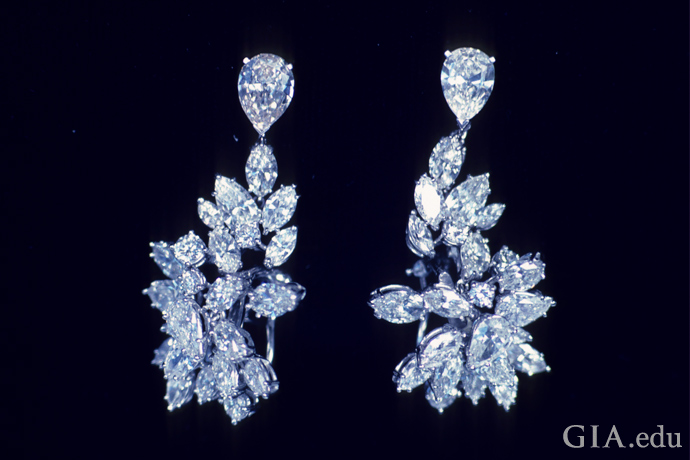
When viewed with incandescent light, all the diamonds in these earrings appear to be the same color. Photo: GIA
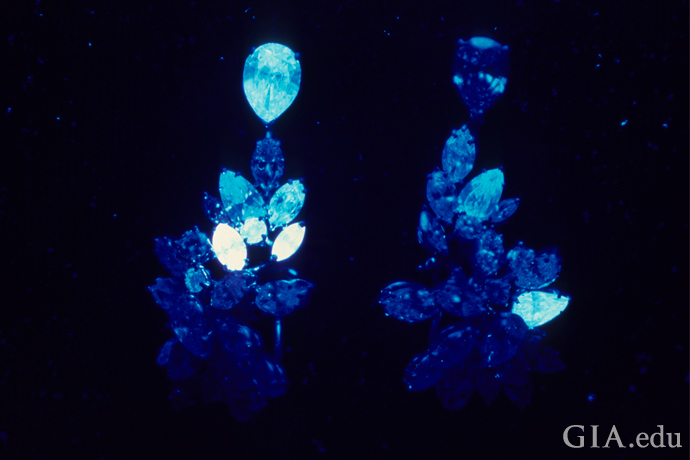
When viewed with a UV lamp, the diamonds in the earrings show different degrees of diamond fluorescence. Photo: GIA
Myth #3: Diamond fluorescence can always be detected
FACT: Diamond fluorescence cannot always be detected. You need conditions where UV rays are present and the intensity of the fluorescence is strong enough to be observed. A reputable grading laboratory, like GIA, follows strict protocols to determine the presence of fluorescence. It also adheres to set standards in describing its intensity, to ensure objective and consistent reporting.
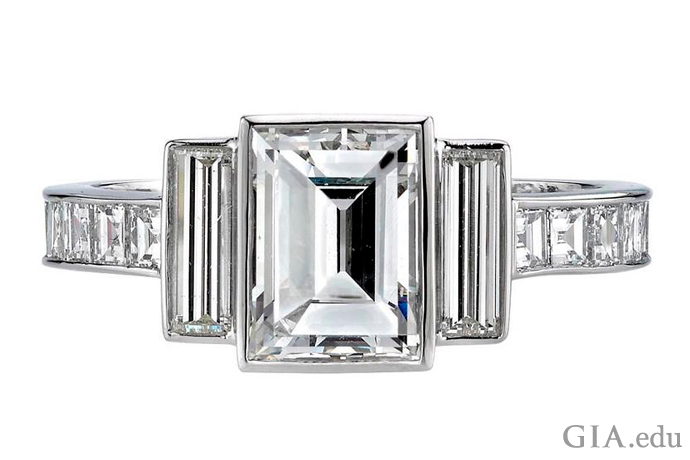
Fluorescent or not, this 1.42 carat (ct) diamond engagement ring, with diamonds lining the band, captivates with its bold, clean lines. Courtesy: 1stdibs.com
Myth #4: Diamond fluorescence influences a diamond’s color grade
FACT: In assigning a diamond color grade, GIA examines the gem in a highly controlled viewing environment, designed to minimize the influence of fluorescence and to produce an accurate and objective assessment of the diamond’s color.
However, the way you perceive a diamond’s color grade may be affected by the extent to which it fluoresces – in a positive way. In a diamond lower on the GIA D-to-Z color scale (say, I to N) with a yellow tint, moderate-to-strong blue fluorescence may cancel out some of the yellow for a better color appearance than what its color grade would indicate. See Myth #7.
Myth #5: Diamond fluorescence is given a grade, just like color, clarity and cut
FACT: Diamond fluorescence is not one of the 4Cs – like color, clarity, cut and carat weight – which describe the quality of a diamond. GIA considers fluorescence an identifying characteristic – additional information that helps distinguish one diamond from another.
GIA diamond grading reports describe the intensity of fluorescence as None, Faint, Medium, Strong and Very Strong. If the fluorescence is Medium, Strong or Very Strong, the color of the fluorescence will be noted on the grading report.
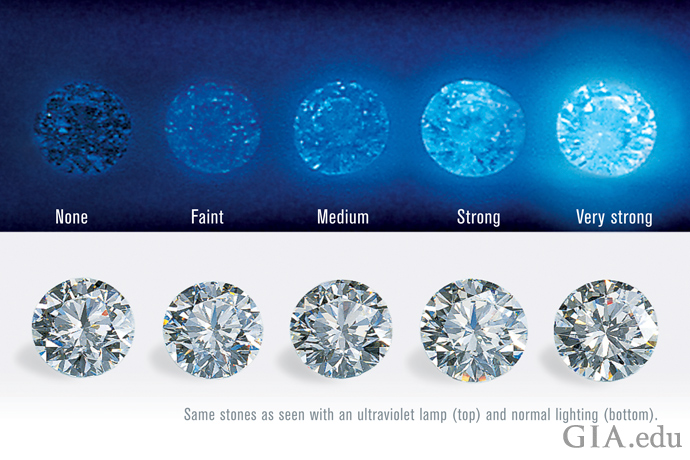
A GIA Grading Report describes the intensity of a diamond’s fluorescence as: None, Faint, Medium, Strong and Very Strong. Composite photo in UV: Maha DeMaggio/GIA. Composite photo in normal light: Harold and Erica Van Pelt/GIA
Myth #6: Diamonds only show blue fluorescence
FACT: Diamonds can fluoresce in a variety of colors. These include orangy yellow, yellow, orange, red, white and green. Variations in the atomic structure, such as the number of nitrogen atoms present, cause the phenomenon. Blue, however, is by far the most common color of diamond fluorescence.

These rough diamonds exhibit a range of colors when exposed to UV light. Photo: GIA
Myth #7: Strong blue diamond fluorescence is bad
FACT: GIA studied the influence of blue fluorescence on the appearance of a diamond under normal viewing conditions. The Institute found that average observers (meant to represent the jewelry buying public) could not consistently discriminate any fluorescence-related effects in the viewing environments most similar to those in which jewelry is purchased and worn.
However, GIA also found that strong blue diamond fluorescence could be beneficial. The results of its study revealed that, as noted for Myth #4, some strongly blue fluorescent diamonds were perceived to have a better color appearance than their color grade would suggest when viewed table-up, with no discernible trend table-down.

Bejeweled fireworks: Half the diamonds in this necklace (132 carats total weight) and the one earring (3.20 ct center stone) in this composite photo are shown under normal lighting conditions (left), and the other half of the necklace and the same earring are shown as they appear under a long-wave UV lamp (right). Composite photo: Harold and Erica Van Pelt/GIA. Courtesy: Harry Winston Inc., New York
Myth #8: Diamond fluorescence detracts from a diamond’s sparkle and beauty
FACT: Diamond fluorescence has little to no effect on a diamond’s sparkle, and research shows that it doesn’t impact beauty either.
A diamond’s sparkle is determined primarily by its cut, not by whether the diamond fluoresces or not. A diamond’s cut – that is, the angles and relative measurements of its facets, as well as its other proportions, design and craftsmanship – determines how well light performs when it strikes the diamond and how well it will sparkle.
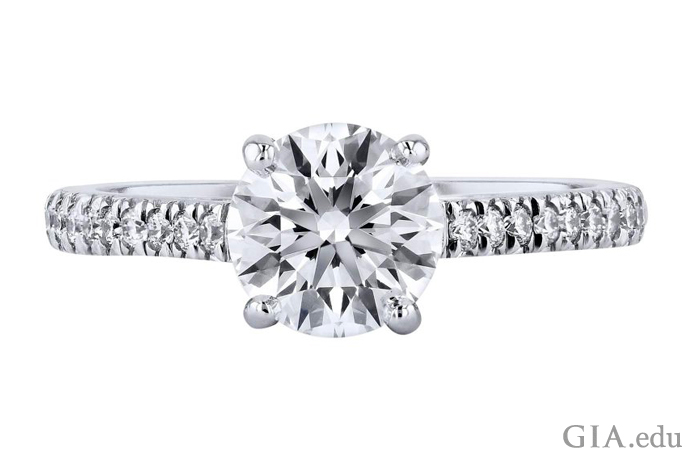
Even strong blue fluorescence would not affect the beauty of this 1.29 ct E color diamond engagement ring in normal lighting. Courtesy: 1stdibs.com
MYTH #9: Fluorescence means the diamond is a “real” natural diamond
FACT: Absolutely not. The presence or absence of fluorescence should not be used as a DIY test to determine if your diamond is real. First, not all natural diamonds fluoresce under the standard UV lamp used by gemologists (see Myth #1). Second, some synthetic or lab grown diamonds do fluoresce to these wavelengths. Although differences have been noted in the intensity, color and pattern of fluorescence between natural and synthetic diamonds, there is overlap. Finally, some materials used to impersonate diamond – like cubic zirconia – can display fluorescence.
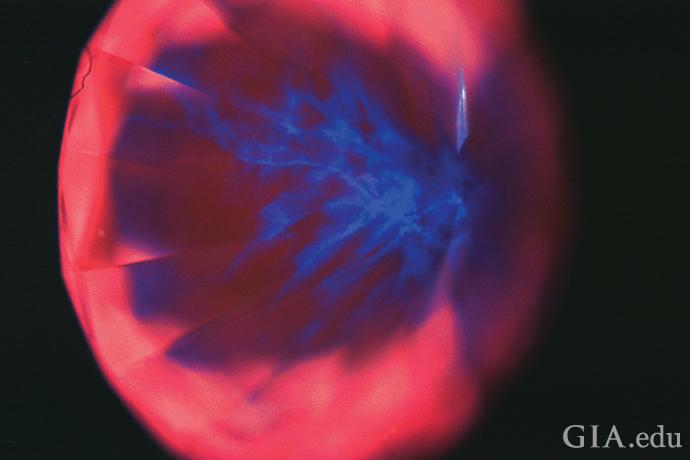
Synthetic diamonds made by the chemical vapor deposition method may display strong pinkish orange fluorescence (among other colors), with regions of strong blue or violet, when exposed to high-intensity ultra-short wavelengths. Photo: Wuyi Wang/GIA
Myth #10: Fluorescence can make a diamond less durable
FACT: A diamond that fluoresces under a standard UV lamp has the same structural integrity as one with no reaction to it. Nothing in the submicroscopic structures that cause fluorescence inherently weakens the diamond.
Myth #11: Diamond fluorescence does/doesn’t affect value
FACT: Jewelry professionals disagree about whether fluorescence adds to or detracts from the value of a diamond. Some trade professionals believe those very rare diamonds at the high end of the D-to-Z color scale that have extremely strong blue fluorescence are worth less than their nonfluorescent counterparts because the fluorescence can affect their transparency by giving them a hazy or milky appearance. Conversely, some traders pay higher prices for blue-fluorescing diamonds of a lower color grade because, as noted above, they believe the fluorescence masks the faint to very light yellow color of these diamonds.
Diamond fluorescence and its effect on value is not a simple question, and there isn’t a simple answer. We recommend that you compare diamonds in a variety of lighting environments and choose the stone that you like best. Ultimately, GIA believes the beauty of a diamond is truly in the eye of the beholder.

Wouldn’t it be awesome if this 1.67 ct center diamond fluoresced in a night club? Courtesy: 1stdibs.com
Is there a diamond fluorescence “fact” you’d like to verify? Leave us a comment below. In the meantime, if you enjoyed this post, you might like reading about common engagement ring myths.
There are so many diamond shapes to choose from when shopping for an engagement ring: round, square, marquise and more. Here’s a guide to what makes each shape special to help you pick the perfect diamond shape for your engagement ring.
First, it’s important to know the difference between a diamond’s shape and its cut. It is common in the diamond marketplace to refer to diamond engagement ring shapes as “cuts.” Shape describes a diamond’s basic outline when viewed face up (round, square, oval, etc.). Cut, or cutting style, refers to how the diamond’s facets are arranged. For example, the most common cutting style for diamond shapes is the brilliant cut with an arrangement of 57 or 58 facets designed to maximize sparkle. So when you find that perfect emerald cut diamond engagement ring, know that what you have is actually a square or rectangular shaped diamond engagement ring.
Some diamonds, most commonly square or rectangular shapes, are step cut. Emerald cut and Asscher cut diamonds are examples. The step cut has concentric rows of facets on the crown and pavilion for a more elegant look. However, not all square or rectangular diamonds are step cut; many are brilliant cut, like the radiant and princess cut diamond.
All diamond shapes other than round are called fancy shapes. Read on to learn more about these diamond shapes:
Round diamond shapes
Rectangular diamond shapes
Square diamond shapes
Marquise diamond shapes
Oval diamond shapes
Pear diamond shapes
Heart diamond shapes
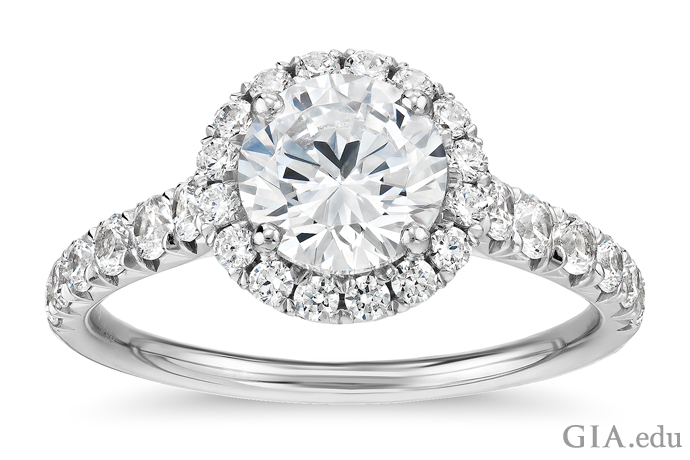
A modern classic: This round diamond shape is brilliant cut to deliver the signature light show we’ve come to associate with diamonds. In this engagement ring, a 1 carat (ct) round center stone is given a boost of additional sparkle by the 0.50 carats of melee set in the halo and shank. Courtesy: Blue Nile
What’s great about round diamond shapes
Round is the most popular of the diamond engagement ring shapes, and it holds this title because the round brilliant cut is designed to produce maximum brightness, fire and sparkle in a colorless diamond. The modern round brilliant cut diamond has a round girdle outline, 56 symmetrically placed triangular and kite-shaped facets, a table facet and an optional culet facet, for a total of 57 or 58 facets.
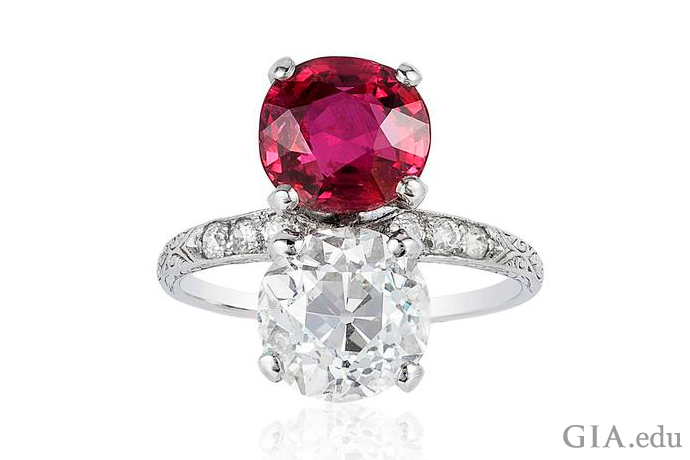
Antique or modern? It’s hard to tell with this delicious pairing of an old European cut diamond weighing 3.03 ct and a 3.01 ct ruby. Courtesy: 1stdibs.com
Lapidaries have been cutting round diamonds for centuries, but it wasn’t until the invention of the bruting machine in the early 1870s that a round diamond could be more easily made with a pleasing, symmetrical outline. The first of these was the old European cut diamond, a precursor to the modern round brilliant cut but with a higher crown and greater total depth than its modern counterpart. The old European cut is still a popular choice for brides wanting an antique look.
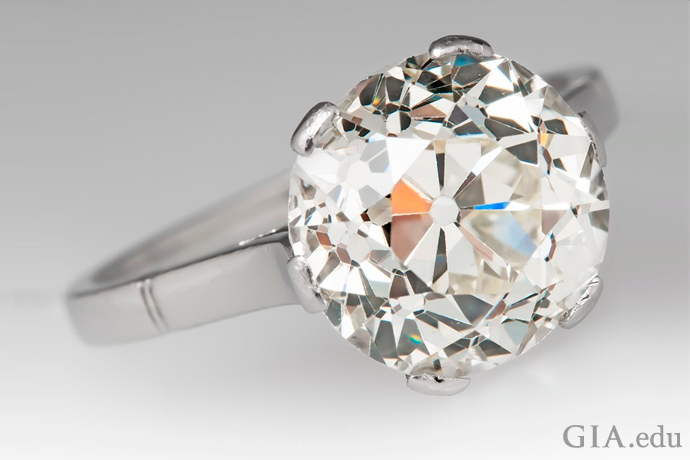
Old World charm abounds in this 5.40 ct old European cut diamond. Courtesy: EraGem.com
What to look for in round diamond shapes
Symmetry is key when shopping for a round diamond to feature in your engagement ring. And if the diamond is cut as a round brilliant, as most are, pay attention to its cut quality, or how well it interacts with light. Look for brightness (often called brilliance) – the internal and external reflections of white light. Fire – the flashes of color seen as you rock the diamond under the store’s spotlights. Sparkle – spots of light that flash when the diamond moves. And scintillation – a combination of sparkle and balanced patterns of bright and dark areas. Well-cut round diamonds are brighter with more fire and scintillation than poorly cut ones, even if they’re of equivalent color, clarity and carat weight.
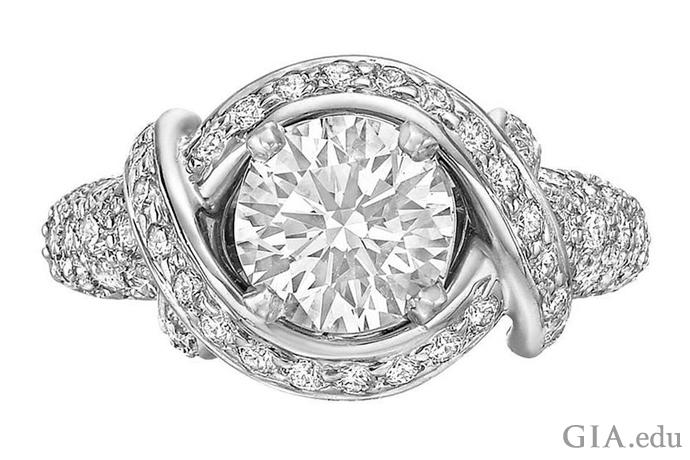
A 1.36 ct round brilliant cut diamond is cradled by twisting bands of platinum studded with 0.96 carats of melee. Courtesy: 1stdibs.com
Avoid diamonds with extremely thin or “knife-edge” girdles or with inclusions near the girdle, which make them more vulnerable to damage.
To be certain of the quality of the cut on your round brilliant diamond, buy one with a GIA diamond grading report, which will provide an objective assessment. Look for a cut grade of Excellent or Very Good.
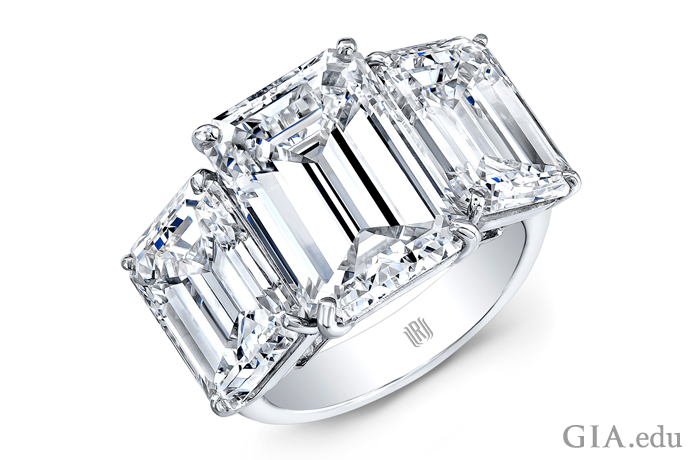
The emerald cut diamond is a long-standing favorite engagement ring shape. Renowned for its sophistication, its streamlined rectangular shape is often associated with the Art Deco period. This modern platinum ring features three emerald cut diamonds totaling 15 carats. Courtesy: Rahaminov
What’s great about rectangular diamond shapes
Rectangular diamond shapes have a long history and a reputation for classic elegance in an engagement ring. The elongated shape can make a bride’s fingers look longer and more slender. Three of the most common rectangular diamond shapes are actually modified rectangles: the emerald cut, cushion cut and radiant cut.
Emerald cut: With its crisp, sophisticated lines, the emerald cut is the most popular of the step-cut diamonds. Its four longer sides have beveled corners with two, three or four concentric rows of facets, parallel to the girdle, on the crown and pavilion. An emerald cut diamond engagement ring is a perennial favorite with the stylish elite.
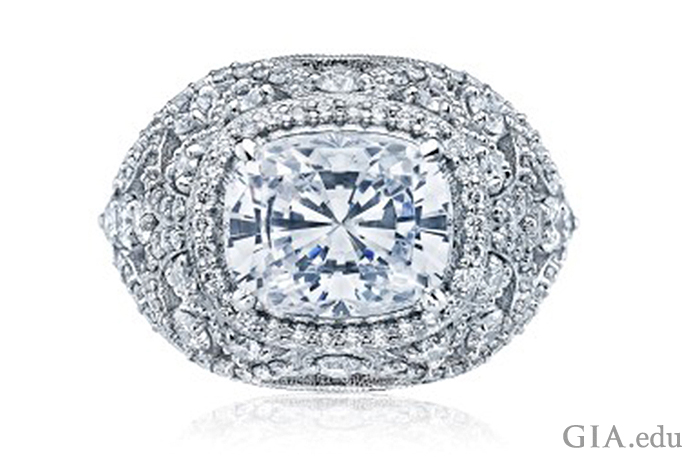
A rectangular shaped cushion cut diamond is the star in this setting featuring a cluster of diamonds and milgrain detail. Courtesy: Tacori
Cushion cut: Adorning the fingers of brides for centuries, the cushion cut diamond has curved sides and rounded corners. It typically has a high crown, small table, deep pavilion and large culet facet. Since the cushion cut retains more color face up than a brilliant cut, a cushion cut is well suited to colored diamonds. A cushion cut diamond will be a hit with a bride who favors an antique style for her engagement ring.
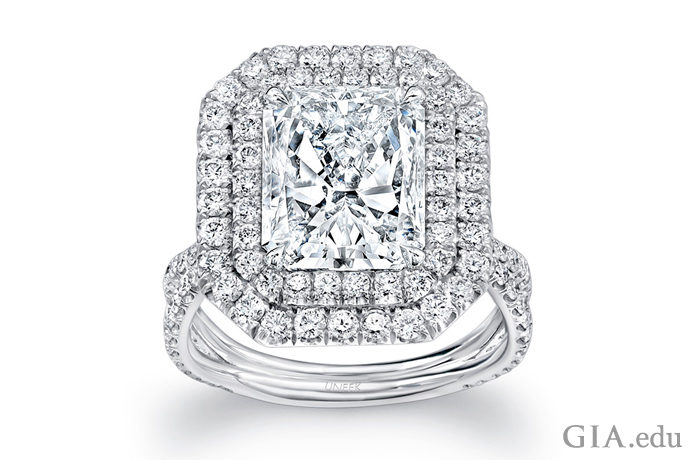
A bride-to-be would happily say “I will” as she puts on this 4.00 ct radiant cut diamond wrapped by two diamond halos. Courtesy: Uneek
Radiant cut: One of the newest rectangular shaped diamonds is the radiant cut, a modified brilliant cut introduced in 1977. It boasts the fire of a round brilliant cut diamond in a rectangular or square shape with cropped corners.
What to look for in rectangular diamond shapes
As with all diamond shapes, symmetry is important for rectangular diamonds. Facets on opposite sides should be parallel to one another, corners should be cropped to identical size and the culet should be well centered.
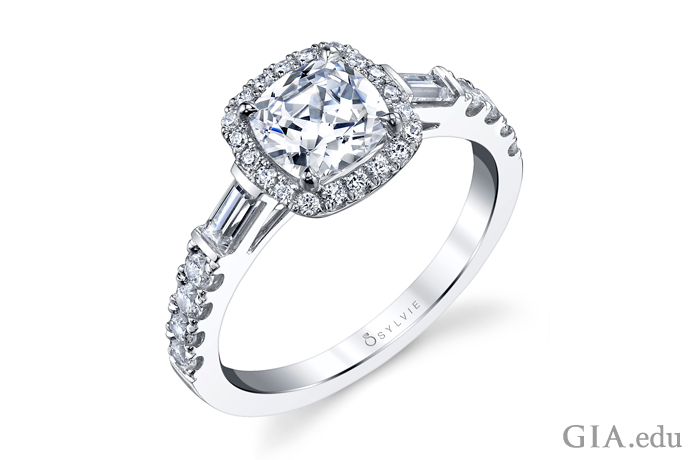
The cushion cut diamond is a shape that is both classic and contemporary. Courtesy: Sylvie Collection
Emerald cuts do not hide inclusions as well as brilliant cuts due to their long rectangular facets, so high clarity is important. Emerald cuts are also less scintillating due to the step cut style of faceting. Since lots of scintillation masks lower color grades, this type of facet pattern looks best on a diamond with higher colors on the GIA D-to-Z color scale. However, it can intensify color in a colored diamond.
For radiant cut diamonds, look for brightness, sparkle and scintillation, as you would for a round brilliant cut diamond. Clarity is less of a concern, as the modified brilliant cut faceting pattern can disguise inclusions that would be more visible in an emerald cut diamond.
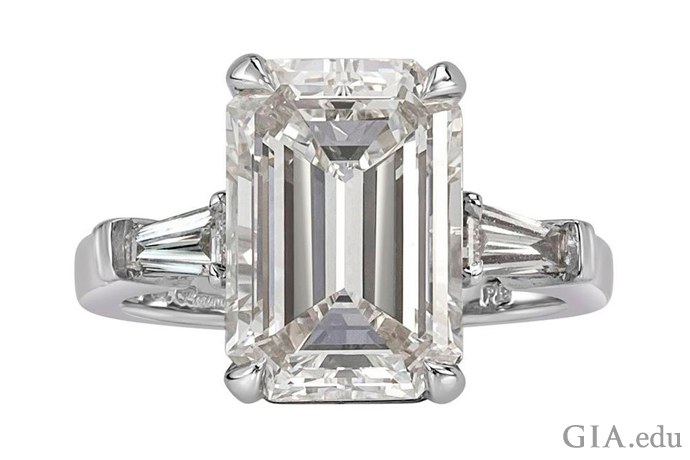
An emerald cut diamond like this 5.89 ct beauty exudes elegance. Courtesy: 1stdibs.com
What’s great about square diamond shapes
Square diamond shapes in engagement rings are perfect for the woman with long, slender fingers who wants them to look shorter. They are also a statement of individuality for a bride who would appreciate a contemporary alternative to the classic round brilliant cut. Want a square shaped diamond in your engagement ring? In addition to the square versions of the cushion cut, emerald cut and radiant cut diamonds described above, consider the princess cut or Asscher cut.
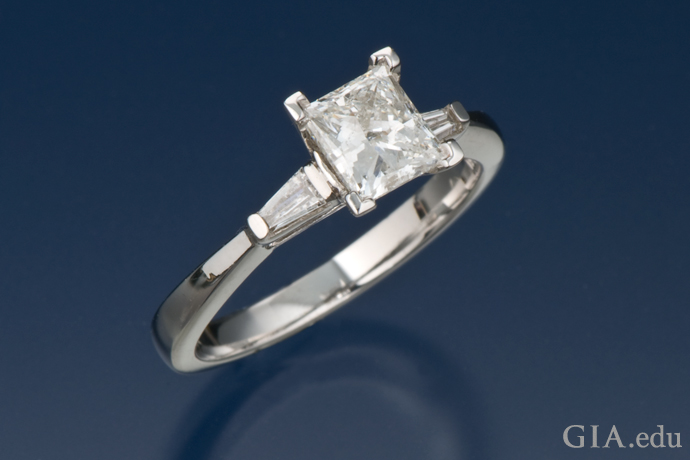
A princess cut diamond shows off its sparkle in this engagement ring. Two tapered baguettes add a dash of drama. Photo: Robert Weldon/GIA
Created in 1981, the princess cut diamond has a modified brilliant facet arrangement that gives it electrifying sparkle and scintillation. For a very different, but surprisingly modern look, the Asscher cut – first introduced in 1902 but since modified for greater brilliance – is similar to a square emerald cut but with larger step facets, a higher crown and a smaller table. Unlike the pointed corners of the princess cut, the corners of an Asscher cut are cropped, giving it the appearance of an octagon.
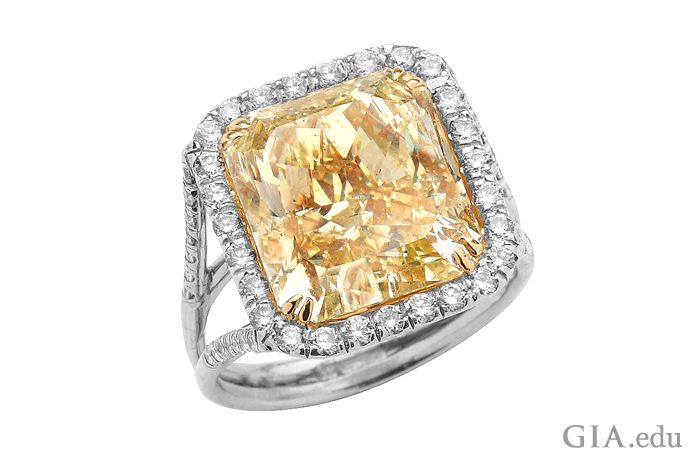
Love the combination of a square shape and a modified brilliant cut? Then you’re sure to fall for a ring like this one – a 9.57 ct Fancy yellow radiant cut diamond surrounded by 0.55 carats of round diamonds. Courtesy: Vivid Diamonds and Jewelry
What to look for in square diamond shapes
Again, look for good symmetry. Facets should match on either side of an imaginary line drawn down the middle of the stone. Look for a balanced contrast of light and dark patterns in the table and other facets.
Fine princess and Asscher cut diamonds will not have a culet facet, which must be taken into consideration when mounting the stone. The culet is a safety facet that helps protect the point on the pavilion from chipping when the diamond is loose or if it is exposed in a setting. In addition, for the princess cut, it is important to choose a prong or bezel setting that protects the pointed corners.
As with emerald cut diamonds, the Asscher cut is most effective for diamonds that are colorless (D–F on the GIA color scale) or colored diamonds.
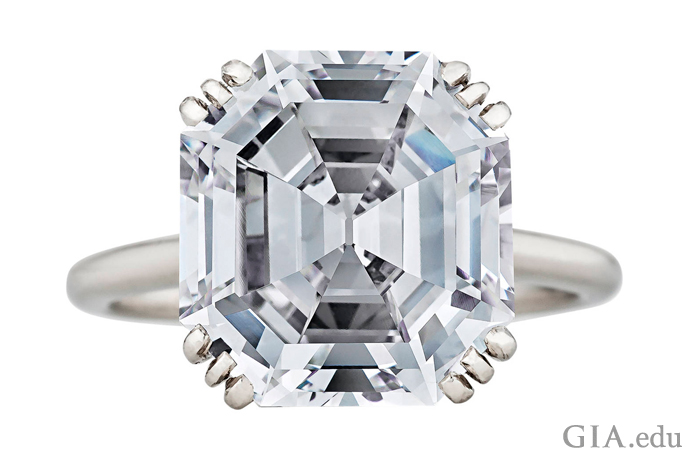
A square-shaped Asscher cut diamond, circa 1935, in a ring by Cartier Paris reflects the by-gone grandeur of the Art Deco era. The 8.06 ct diamond is mounted in a 12-prong platinum setting. Courtesy: 1stdibs.com
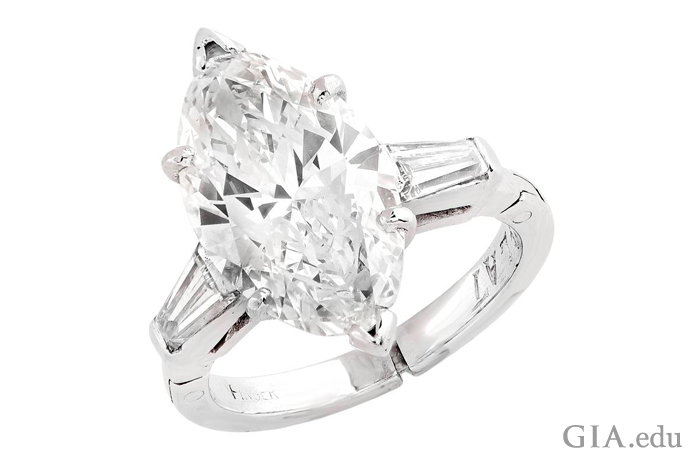
This stunning 3.50 ct marquise shaped diamond is set in platinum with its delicate tips protected by V-shaped prongs. Courtesy: 1stdibs.com
What’s great about marquise diamond shapes
An attractive, elongated shape with a royal pedigree, the marquise (pronounced “mahr-keez”) was supposedly named for the Marquise de Pompadour, a mistress of King Louis XV, as its outline resembled the shape of her mouth. Because of its shape, a marquise diamond ring will look larger face up than a round diamond of the same weight. A marquise diamond engagement ring can also make the finger appear longer and more slender.
What to look for in marquise diamond shapes
Several factors must be considered when choosing a marquise diamond for your engagement ring. You want a marquise that is neither too long (and thus may sacrifice brightness and pattern) or too short (“stubby”) and thus loses the benefit of length to your bride’s finger. The points at either end should be sharp.
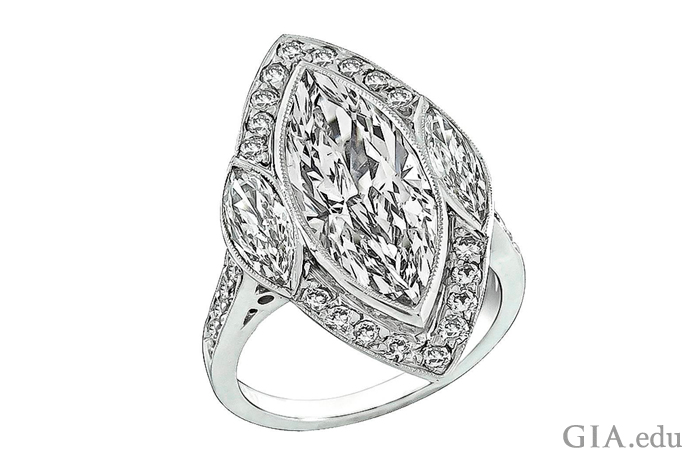
Note the regal gentility of this 0.91 ct marquise diamond and the two smaller marquise side stones. Courtesy: 1stdibs.com
Symmetry is extremely important for marquise diamonds. Both sides (wings) should have the same amount of curve, and the facets on one side of that imaginary line down the center of the diamond should match exactly the shape and size of the facets on the other side. Since the tips of a marquise diamond are where it is most vulnerable, it is not unusual for them to have slightly greater girdle thickness. If the marquise diamond is prong set, choose V-shaped prongs for the tips. A well-cut marquise will typically display a minimal to no bow-tie pattern.
Learn how to spot the bow tie effect in diamonds.
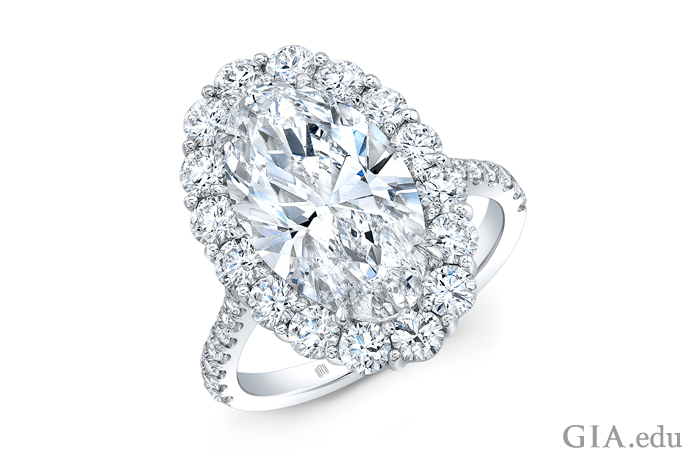
Oval diamond shapes are making a comeback, and it’s easy to see why in this 18K white gold ring featuring 5.31 carats of diamonds from the Moval Collection by Rahaminov Diamonds. Courtesy: Rahaminov Diamonds
What’s great about oval diamond shapes
Although a shape that is many hundreds of years old, the oval diamond has gained popularity for engagement rings in recent years because of its elegance and the fire it shows when cut in the brilliant faceting style. In addition, with its greater surface area, an oval diamond may appear larger than a round brilliant diamond of the same weight (and, like rectangular and marquise diamonds, can help elongate shorter fingers). One advantage over other fancy shapes is that the rounded edges make it less prone to chipping.
What to look for in oval diamond shapes
Pay attention to proportion. Longer oval diamonds are preferred by some, but they are not practical to cut so tend to be harder to find.
As with other fancy diamond shapes, symmetry is essential to ensuring beauty in an oval diamond. Again, placing an imaginary line down the length of the diamond and then across its center, the shape and faceting of the two halves should be identical.
Also look for a graceful outline and the size and nature of the bow-tie pattern. The bow tie on a well-cut oval diamond will be minimal or non-existent.
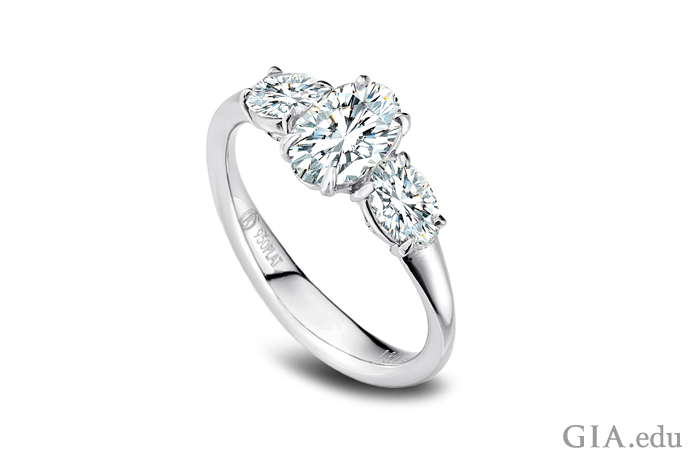
The virtues of an oval cut diamond are easy to see in this engagement ring. Courtesy: Platinum Guild International, USA
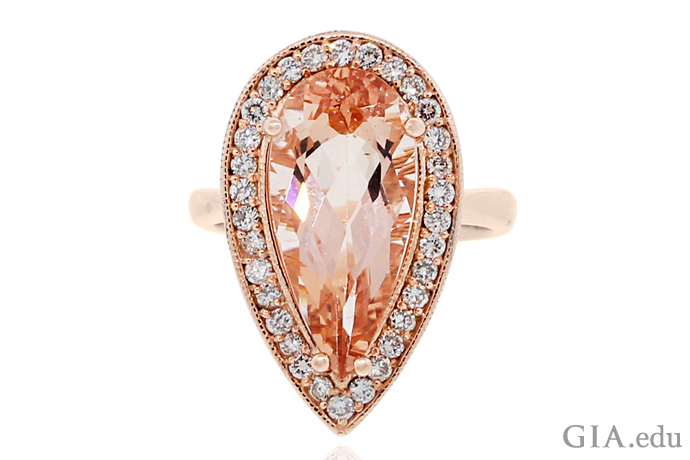
The pear shape is not just for diamonds. In fact, it’s a popular shape for the newest trend – morganite engagement rings. This 14K rose gold ring features a 5.76 ct morganite, surrounded by 0.58 carats of round diamonds. Courtesy: TrueFacet.com
What’s great about pear diamond shapes
An irresistible blend of the marquise and round brilliant, the pear shaped diamond is a stylish choice among diamond shapes. Worn with the point toward the tip of the finger, its graceful, tapered shape can make the hand look slimmer and more elegant, perfect for an engagement ring.

Looking for inspiration? You don’t need to look further than this 8.41 ct Fancy Vivid purple-pink pear shaped diamond ring. It sold at a Sotheby’s Hong Kong auction for $17.7 million on October 7, 2014. Courtesy: Sotheby’s
What to look for in pear diamond shapes
Pear shaped diamonds come in a variety of proportions, so there are many options for choosing one that flatters the finger. Look closely at the wings on either side of the point to make sure they are symmetrical, with the rounded end a good semi-circle. Since the point is the weakest feature, look for (and avoid) inclusions in that area. If prong setting the diamond, use a V-shaped prong on the point for greater protection.
As with oval and marquise diamond shapes, the bow-tie pattern on the table should be minimal, or better yet, non-existent.
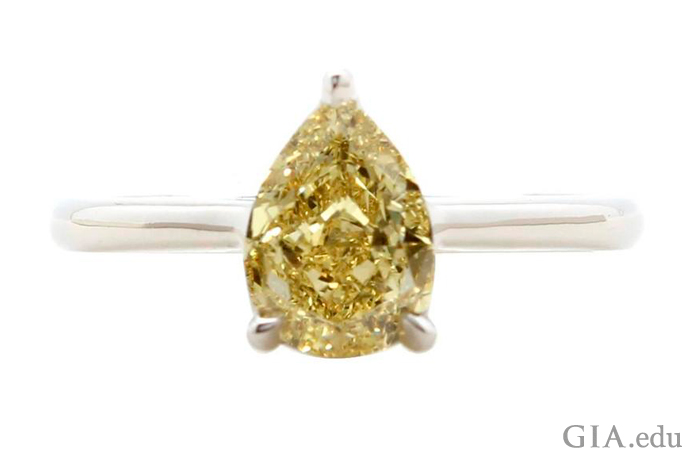
This 1.39 ct fancy yellow pear shaped diamond glows like a star in the evening sky. Courtesy: 1stdibs.com
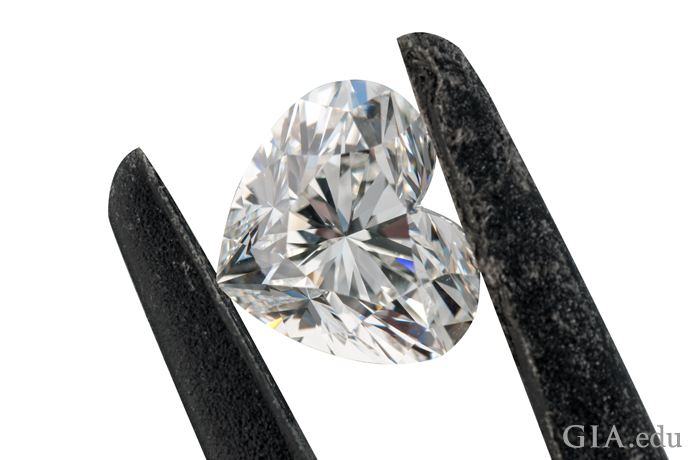
Like true love, a heart shaped diamond may be hard to find, since this shape works best with larger diamonds of good clarity. Photo: Robert Weldon/GIA
What’s great about heart diamond shapes
The heart shaped diamond is the essence of romance. It is also a very flattering style for larger fingers.
What to look for in heart diamond shapes
There are good reasons why this is one of the rarest of diamond shapes for engagement rings. A well-shaped heart requires a large diamond, at least one-half carat. In addition, inclusions tend to be more prominent in this shape, so you want a diamond that has good clarity. Symmetry is also key: The well-rounded lobes should match in size and shape, as well as faceting style, and the cleft between them (as well as the point) should be well defined.
Ready to shop for your favorite diamond shape engagement ring? Follow the links for more tips and inspiration:
Round Shaped Engagement Rings
Emerald Cut Engagement Rings
Radiant Cut Engagement Rings
Cushion Cut Engagement Rings
Princess Cut Engagement Rings
Marquise Shaped Engagement Rings
Pear Shaped Engagement Rings
Oval Shaped Engagement Rings
Heart Shaped Engagement Rings
With its graceful, tapered outline, a pear shaped diamond is an elegant and flattering choice for an engagement ring. Here are the essentials for selecting the perfect pear shape.
Jewelers consider the pear shaped diamond a “fancy shape,” meaning it’s a shape other than round. Reminiscent of a tear drop, a pear shaped diamond blends the best of the round and marquise diamond shapes.
Since the parts of a pear shaped diamond contribute to its beauty, you should get to know them. Then you can shop for a pear shaped diamond engagement ring with a discerning eye.
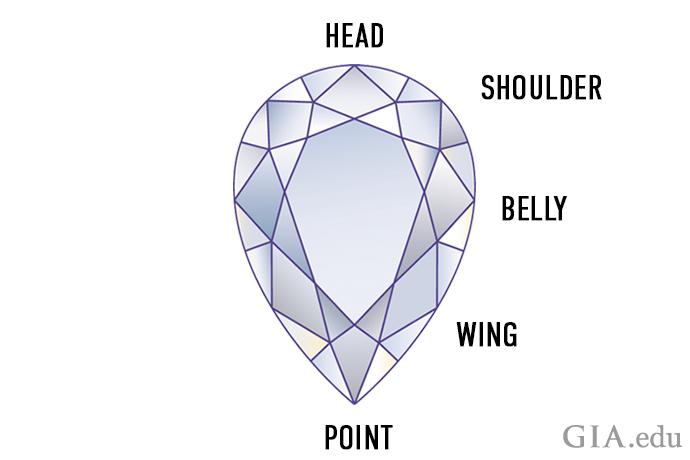
You’ll want to be able to name the parts of a pear shaped diamond when you’re looking at various stones. This shows the retailer you’re an informed buyer. Illustration: Peter Johnston/GIA
Look at the diamond face-up and pay attention to its outline. A pear shaped diamond should have gently rounded shoulders and wings. The wings should form attractive arches. If they’re too flat, they make the stone look too narrow. If they’re too rounded, they make it look short and stubby.
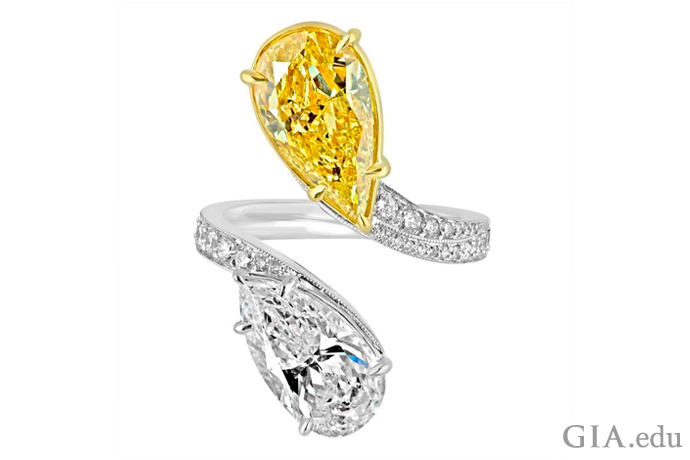
A bejeweled pair of pears: a 4.06 carat (ct) yellow pear shaped diamond is nestled against a 3.02 ct colorless diamond. The band, which flows from 18K white gold to yellow gold, echoes the colors of the stones. Courtesy: 1stdibs.com
The pear shaped diamond, like the round brilliant diamond, is faceted to deliver the most sparkle and brilliance. Here are the names of important parts of a faceted diamond, which you should know and are used in this blog:

On a black background, this 3.83 ct pear shaped diamond shines like a star in the night sky. Photo: Robert Weldon/GIA. Courtesy: Atelier Marisa
Like many other fancy shapes (such as the marquise or heart shape), a pear shaped diamond tends to hold more color than a round brilliant. Therefore, it is best to choose a diamond that is high on the GIA color scale or a fancy-color diamond.

Because pear shaped diamonds tend to hold more color than round brilliant diamonds, it is best to choose a diamond that is high on the GIA color scale or a fancy-color diamond like this 1.21 ct Fancy purplish pink diamond engagement ring set in 18K gold. Courtesy: 1stdibs.com
Symmetry is key to the overall beauty of gemstones, but it’s even more important in some fancy-shape diamonds like oval diamonds, heart shaped diamonds, marquise diamonds and pear shapes. To see if a pear shaped diamond is symmetrical, draw an imaginary line down the length of the gem and examine the two halves. The more closely they mirror each other, the better the symmetry is.
Notice how the shoulders, bellies and wings in the illustration below are identical on either side of the line, and how the shape, size and placement of the facets in each half of the stone mirror one another. This is an ideal pear shape. You can use the illustration as a guide when picking a pear shaped diamond.
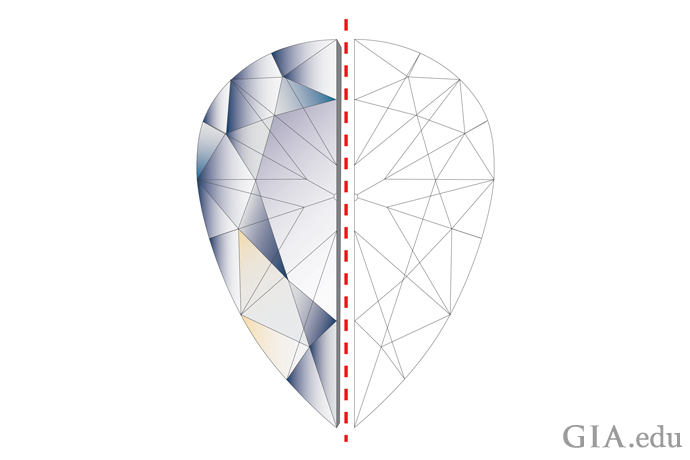
Illustration: Peter Johnston/GIA
When GIA diamond graders evaluate the symmetry of fancy-shape diamonds, which includes pear shapes, they also look for things like a balanced and even outline. Certain types of asymmetry and uneven proportions are considered by most in the jewelry trade to have a negative effect on the appearance of a pear shaped diamond. These include:
Uneven shoulders and uneven wings are other variations that will detract from the appearance of a pear shaped diamond. The illustration below has both.
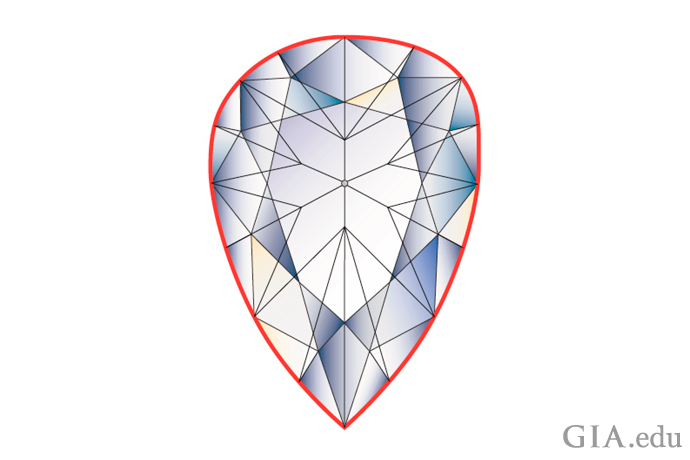
The uneven outline of this pear shape reveals the asymmetry of its shoulders, belly and wings. You might want to avoid a diamond cut like this. Illustration: GIA
You might run into the phrase “length-to-width ratio” (comparison of the length and width of the outline of many fancy-shape diamonds, determined by dividing the diamond’s length by its width and stated as a ratio, like 1.75:1). Many experts prefer a length-to-width ratio that lies in the range of about 1.50–1.75:1. Others in the trade believe that a ratio isn’t enough to convey a diamond’s beauty. You may want to let your heart and eye guide you.
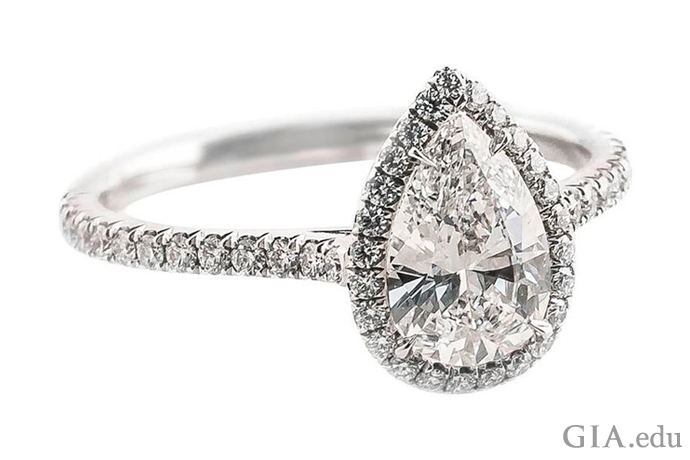
Falling in love with any diamond is more than finding the perfect symmetry and length-to-width ratio. Are you infatuated with this 0.88 ct pear shaped diamond? Courtesy: 1stdibs.com
The placement of the culet on a pear shaped diamond can affect its appearance. It should be the same distance from the two sides of the diamond. A culet that is off-center will affect the diamond’s symmetry and is likely to make it less attractive. In some pear shapes, the culet is included in a keel line that extends down the length of the diamond where the pavilion facets meet. Like the culet, the keel line should be equidistant from either side of the diamond.

The culet on this pear shaped diamond is off-center. It should be symmetrically placed at the same distance from either side of the gem. Illustration: GIA
Note, too, whether the diamond has any inclusions, especially near its point, as this is the area of that is most sensitive to damage. In addition, if the pear shaped diamond has a larger table facet, inclusions could be more apparent, so good clarity is a consideration.
A poorly placed table facet can also make a pear shaped diamond look less attractive. For maximum brightness and fire, the table should be centered on the line of symmetry.

If the table is off-center, the crown facets on one side of the pear shaped diamond will appear larger than the facets on the opposite side. Illustration: GIA
Many pear shaped diamonds show a dark pattern that resembles a bow-tie. This pattern typically runs across the width of the stone from the center of the table. The bow-tie on a well-cut pear shaped diamond should be minimal, but there will still be good contrast between light and dark areas in the stone.
A bow-tie can vary from light gray to black. The darker or larger it is, the more it detracts from the face-up appearance of a pear shaped diamond. A bow-tie gets darker as the difference between a diamond’s length and width increases and pavilion angle variations (the measured angle between the pavilion main facet plane and the table plane) become more extreme.
If you find the bow-tie effect distracting, be sure to examine a variety of pear shaped diamonds from different angles under the lighting conditions in which the engagement ring will be worn. You may not be able to avoid a bow-tie altogether, but you should be able to find a stone in which it is subtle.

These pear shaped diamonds display a bow-tie effect, the dark area that extends across the width of each stone. Photo: Nicholas DelRe/GIA
The most vulnerable part of a pear shaped diamond is the point. This area can be protected by placing a V-prong on the point or choosing a bezel setting around the entire stone.

A V-prong protects the point – an area susceptible to chipping – of this 8.25 ct pear shaped diamond. Four more prongs hold the diamond securely in place. Courtesy: 1stdibs.com

A bezel setting ensures that the 0.40 ct pear shaped diamond is well protected. Courtesy: Doyle & Doyle
The traditional way to wear a pear shaped diamond engagement ring is to have the tip pointing away from you (down). According to many in the trade, this makes the finger look more slender. But tradition has its limits. Some brides choose to wear this shape with the point toward them (up). And some prefer a horizontal setting that gives this classic diamond shape a distinctive, contemporary look.
Like all matters of the heart, let yours decide which way the pear should point.

Whether the tip of the 1.34 ct pear shaped diamond points toward or away from you, an engagement ring like this will look spectacular on the finger. The center stone is surrounded by 43 radiant cut diamonds weighing 0.41 carats and 1.03 carats of sapphires. Courtesy: 1stdibs.com
Among the most elegant of the fancy shapes, a pear shaped diamond conveys both the delicacy of a single tear and the strength of the brightest star. While there are many factors to consider when searching for the perfect stone for your diamond engagement ring, it is a journey well worth taking. When deciding between different pear shaped diamonds, the overall appearance is more important than the specific proportion details. Often, what makes a pear shaped diamond attractive is a matter of personal taste. So enjoy looking at different pear shaped diamond engagement rings until you fall in love with the perfect one.
Before you go shopping, be sure to read our 12 tips for buying an engagement ring.
Antique and vintage engagement rings are in fashion – and for good reason. They have an undeniable charm and style. They are a beautiful piece of the past. They’re lasting symbols of love. Here’s how to pick one that you’ll cherish.
In this blog, we cover:
Establishing a budget for antique and vintage engagement rings
Understanding the difference between antique and vintage engagement rings
Important jewelry periods for antique and vintage engagement rings
Diamond cuts typical of antique and vintage engagement rings
Challenges with buying antique and vintage engagement rings
Where to find antique and vintage engagement rings
Prices for antique and vintage engagement rings run the gamut from less than $1,000 to more than $100,000. Put another way, there are beautiful rings for every budget. Deciding what to spend is a personal decision that balances practicality and love. You know what’s best for your circumstances.
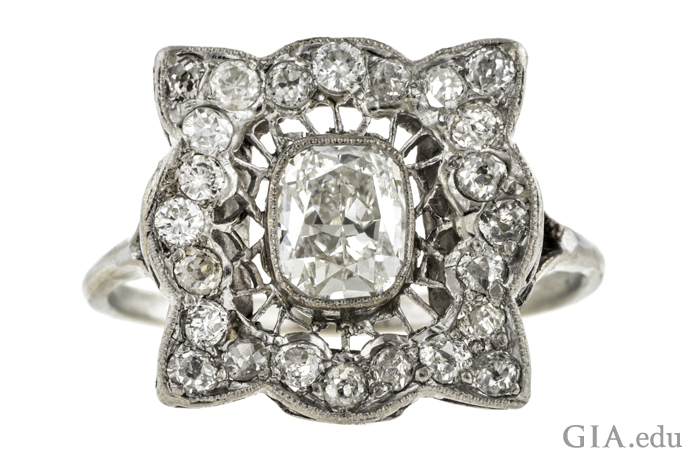
If you’re looking for an antique engagement ring, aristocratic elegance is a hallmark of the Edwardian era. In this intricate creation, a 1.12 carat (ct) cushion cut diamond nestles within approximately 0.48 carats of diamond melee. Courtesy: Doyle & Doyle
Before we dive into the details of shopping for antique and vintage engagement rings, here are a few terms you need to know:
Understanding the difference between antique and vintage engagement rings will be helpful for your search. If you’re interested in an engagement ring from a specific period, like the Victorian era, you’ll want to use the proper terminology to help the retailer find the appropriate pieces. It also shows that you’re an educated customer.

With its heart shaped moonstone cradled in a halo of diamonds, this Victorian era engagement ring sparkles with romance. Courtesy: 1stdibs.com
Throughout history, certain periods or cultural movements have had a signature jewelry style. Your delightful challenge will be finding antique and vintage engagement rings and choosing one that best captures the spirit of your love. Here are brief descriptions of rings made during some of the more important jewelry periods.
Learn more about Victorian style engagement rings.

An engagement ring with a snake motif might seem unusual to modern eyes. To Victorians, the serpent symbolized love, eternity and wisdom. Two coiled serpents are set with ruby, diamond and emerald. Courtesy: 1stdibs.com
Learn more about Art Nouveau engagement rings.

Dramatic swirling lines, a signature of Art Nouveau jewelry, infuse this ring with a sense of movement while diamonds add sparkle. Courtesy: 1stdibs.com
Learn more about Edwardian engagement rings.

This 1.63 ct elongated oval diamond is surrounded by milgrain and delicate open work that are characteristic of the Edwardian era. Courtesy: LangAntiques.com
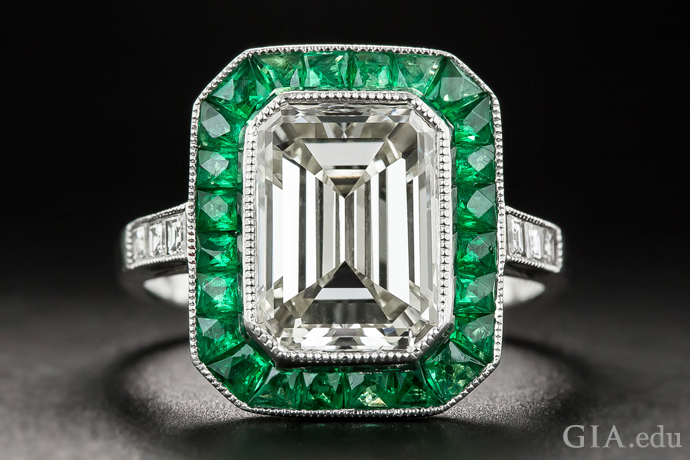
A 3.00 ct emerald cut diamond bordered by emeralds captures the geometric patterns and contrasting colors that are classic Art Deco. Courtesy: LangAntiques.com
Learn more about Art Deco engagement rings.
Learn more about Retro-style engagement rings.

Wearable sculpture is a perfect way to describe this Retro era engagement ring. The diamonds shine brighter for being juxtaposed against rubies. Courtesy: Lang Antiques.com
If you’re looking for antique engagement rings, you’re likely to come across the terms old mine cut and old European cut diamonds.
An old mine cut diamond is a squarish or cushion shaped brilliant with many proportion variations that was often used in jewelry during the Georgian (1714–1837) and early to mid-Victorian periods. Although it has 58 facets like most modern round brilliant cut diamonds, it typically has a smaller table, larger culet and higher crown. It also has short lower half facets and a girdle that is very thin in places, which contribute to its distinctive look.
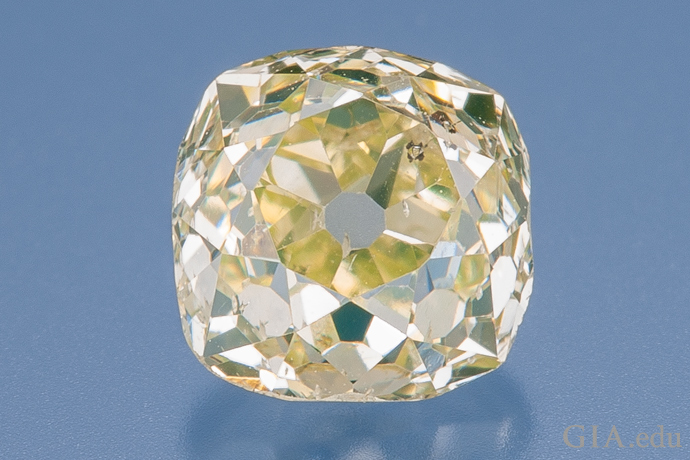
No two old mine cut diamonds are identical. This one weighs 0.68 ct. Photo: Orasa Weldon/GIA
The old European cut emerged as advances in diamond cutting technology in the late 1800s made it possible to fashion round girdles, like the modern round brilliant, though it has a higher crown, very small table and greater total depth. It is typically found in jewelry from the late Victorian era, the Edwardian era and the Art Deco period.

This 0.99 ct old European cut diamond has a stately elegance. Photo: Orasa Weldon/ GIA
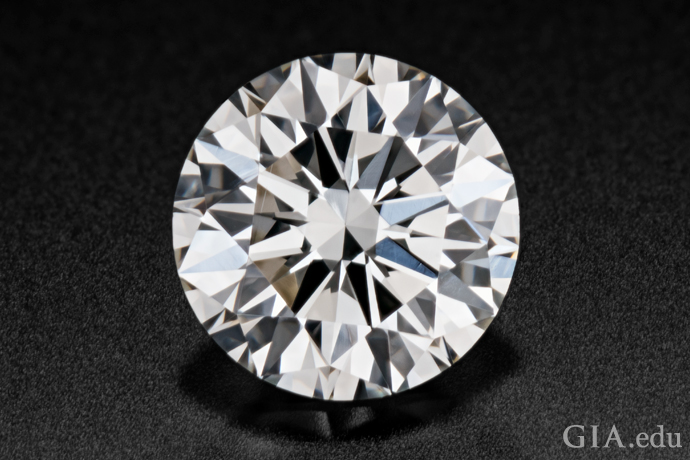
The round brilliant cut diamond, here at 0.73 carats, has been the standard for engagement rings since the mid-20th century. Photo: Kevin Schumacher/GIA
Antique and vintage engagement rings can be a unique choice for your bride-to-be, but there are some challenges you should be aware of before you make a purchase.
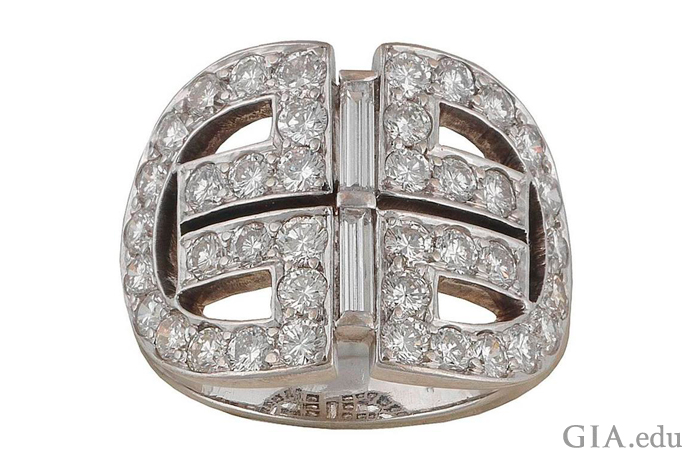
A distinctive geometric pattern with both strong angles and curves incorporates two baguette diamonds weighing approximately 0.60 carats and about 2.00 carats of melee in this Retro era ring. Courtesy: 1stdibs.com
A number of websites specialize in antique and vintage engagement rings. To determine if an online retailer is trustworthy, look to see how long they have been in business and if they are in good standing with the Better Business Bureau. Be sure to speak with retailers directly both to get answers to your questions and see if they are knowledgeable professionals. It is wise to purchase items with diamonds that come with GIA Grading Reports. Our blog on the Five Non-Negotiable Rules for Buying Jewelry Online has more essential information that may be helpful during your search.
Auction catalogs and websites that sell estate jewelry are two other sources. In addition, you can search the GIA Retailer Lookup for retailers who carry GIA-graded diamonds. Some of them also sell antique and vintage engagement rings, so it may be a good place to start.
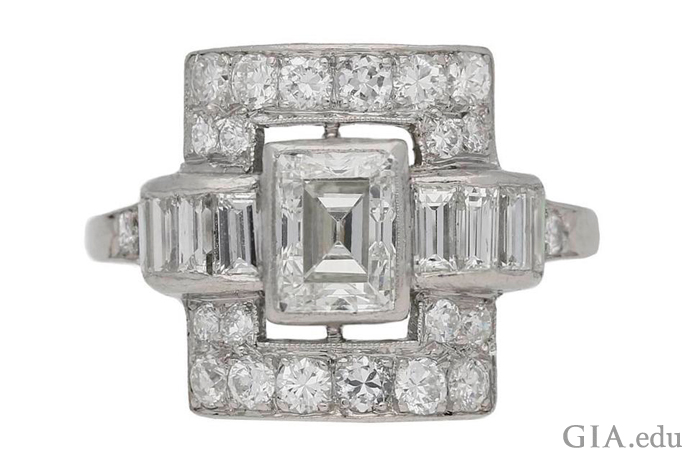
Contrasting geometric shapes create a sum greater than its parts in this Art Deco ring. A 0.85 ct octagonal emerald cut diamond is the center stone, accompanied by eight rectangular baguette cut diamonds and a group of round old European cut diamonds. Courtesy: 1stdibs.com
Once you find your perfect antique or vintage engagement ring, consider getting an unbiased appraisal from an experienced jeweler or independent jewelry appraiser. The appraisal should provide you with a full description of the piece, including its condition, as well as validate its historical period and estimate its value.
Searching for antique and vintage engagement rings can be like going through a treasure chest filled with lots of precious surprises. If you’re having a tough time finding one that’s right for you, consider creating a custom engagement ring with these antique and vintage styles in mind.